#lyndy abraham
Text
The Imagination Chamber - Alchemy
The most obvious bit of alchemical symbolism comes toward the beginning of the book, in a passage that describes Lyra hanging out with the gyptians. She observes Piet Van Poppel painting a traditional “rose-and-lily” pattern onto his boat.
...back in her room trying to paint it on her second-best dress before realizing that it would be better embroidered. And very soon after, having pricked her fingers countless times and snapped the threads and lost all patience with the task, throwing it away in disgust, and having to explain its absence to Mrs. Lonsdale. (p. 7)
The lily is a symbol for the albedo, the White stage of the alchemical process; the rose symbolizes the rubedo, the Red--final--stage. Both are female names and have been used to mark characters in fantasy stories. For example, Lily Potter, Harry’s mother, who saves her son but perishes herself, and Rose Cotton, who marries Samwise Gangee in the matrimoniathon at the end of Lord of the Rings.
It’s not clear exactly how old Lyra is at this point, but alchemically she is firmly in the nigredo, the Black stage. Her attempts to reproduce the lily and rose fail miserably. She even injures herself in the process. An embroidery needle may be small, but it is a piercing instrument, just like a sword, and as such is a symbol for the fire of the coagula.* Perhaps this is even a foreshadowing of injuries she will suffer in the Secret Commonwealth (”Little Stick”).
At this point Lyra is far from the transformation she will experience at the end of the Amber Spyglass: she is impatient, rash, reckless, and not ready to don a lily- and- rose emblazoned garment.
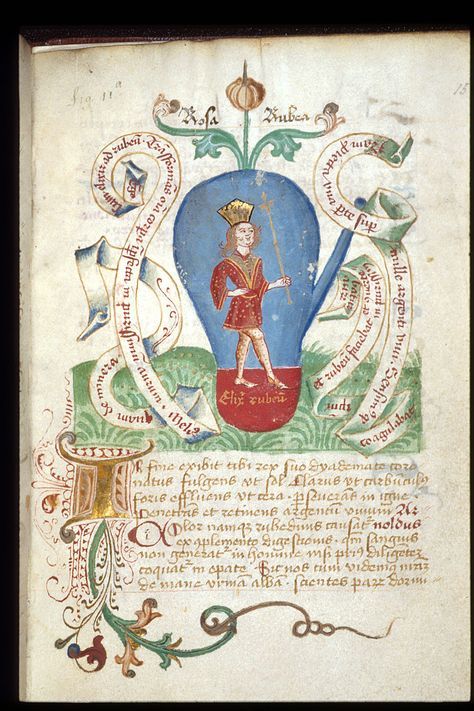
Rosa rubea, the Red King in his red robe.
*As Lyndy Abraham explains in her Dictionary, “weaponry” is “a symbol for the action of the philosophical fire, especially at the initial stage of the opus known as the black nigredo.”
#the imagination chamber#philip pullman#lyra belacqua#lily#rose#alchemy#alice lonsdale#lyndy abraham#rosa rubea#philosophical fire#his dark materials
8 notes
·
View notes
Text
The Tree Is Not Death; It's Alchemy
I've written before about the philosophical tree in RWBY, and the recent episodes kind of confirm that it is indeed intended to represent the process of alchemy.
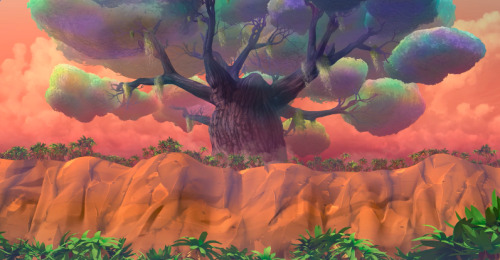
Curious Cat: (clears throat) Now that Herb’s properly returned, he’ll be fixed up nice, and made into the Herb he wanted to be when he was still “Herb”. Then he’ll come back and find his purpose. Could be the same as before, or maybe not.
Ruby: When Herb comes back, will he remember anything?
Curious Cat: (laughs) What would be the point of that? (stretches) Just like Alyx, you lot. I know, I know, where you're from, things… (shudders) …die… but we’re just not like you at all. We… ascend. Herb will have a purpose again.
Jaune: That Tree is death. It absorbs you, takes your memories and turns you into something else. If you go there, it's going to erase you. They call it ascension...
The thing about alchemy is that it's fundamentally about the union of opposites, including life and death. It sees life and death as feeding into one another rather than opposing one another, as symbolized in the classic ouroboros. An ouroboros is a snake eating its own tail; it kills itself and gives birth to itself.

You might notice the six pointed "star of antimony," aka another alchemical symbol, in the middle of the orobouros, which is a shape that appears not just in the starfish at the shores of the Ever After, but the flowers from this episode.
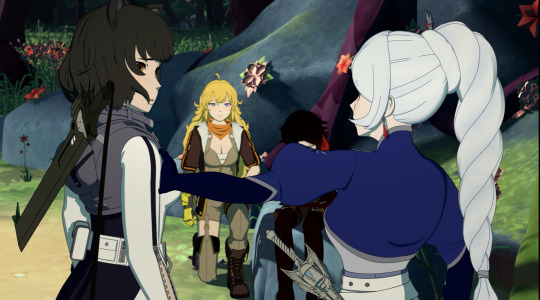

The six pointed star in alchemy has each of its triangles representing heaven and earth, and weds them together. Hence, the Ever After and Remnant, life and death, mind and heart, spirit, soul, and body. It's where "man is made perfect," according to Lyndy Abraham, and where the substances being transformed (in this case, our characters) "breaketh into water like Gold... this is the Starr of the Wise."
Currently, RWBYJ are approaching the concept of "ascension" as something like death, when it's not quite accurate. The reality, however, is that it is perfectly normal for them to see it this way, since humans are by nature limited in our experiences. Empathy is a tool to reach outside of ourselves, but there is no way to truly be another person or to have another purpose.
Lyndy Abraham notes that "the tree symbolizes growth and fruition, in both a physical and spiritual sense. It represents the development of the arcane substance from the prima materia (the original stuff of creation) to the ultimata materia, the all-transforming philosopher's stone."
Clearly, it will be at the tree where the volume climaxes, and also at the tree where they are restored to their world (physical and spiritual). But none of them will ever get home until they come to understand that there is no life without death, of solve et coagula (dissolve and coagulate, rinse away the impurities to continually refine the "stone," which are characters here).
Our quintet needs to come to an alchemical perception of death feeding life, which is not the same as "ra, ra, sacrifice is the highest purpose!" (Which I suspect we'll explore through Ruby and Jaune at the climax.) I would bet a lot that the tree completes Jaune's transformation into gold, and also Weiss becomes the "Starr of the Wise," given her associations with being "wise" according to the Cat already (and also her frequent associations with it throughout the story).
Curious Cat: Looking at you, wise huntress.
But that's not all! No, the tree is also associated with roses. See the below image, which yes, has the tree blooming from the ouroboros itself. (These are apparently supposed to be roses.) The fruit of the tree is usually gold and silver.
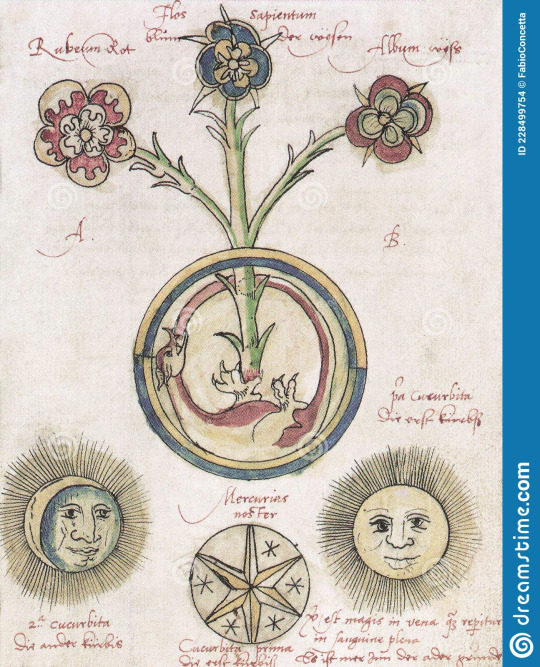
Rather than fearing the tree, Jaune and Ruby will both be restored by it (which doesn't mean they will be remade--Jaune might be remade, because somehow he's returning to his previous self, but how, we'll see). Ruby will not solve all her problems here, but I would bet she'll come to a better place and a better understanding of her identity as Ruby Rose, a Huntress with silver eyes, at the tree, even if that understanding is more a desire to find who she is than an answer.
The Star of the Wise shows up several other times in alchemical symbolism, too, most notably as Sophia, or personified wisdom. See here, in Splendor Solis, where Sophia (crowned with the six pointed star) robes a resurrected being. Yes, the being is being resurrected; the name of this image is "Resurrection from the Swamp."
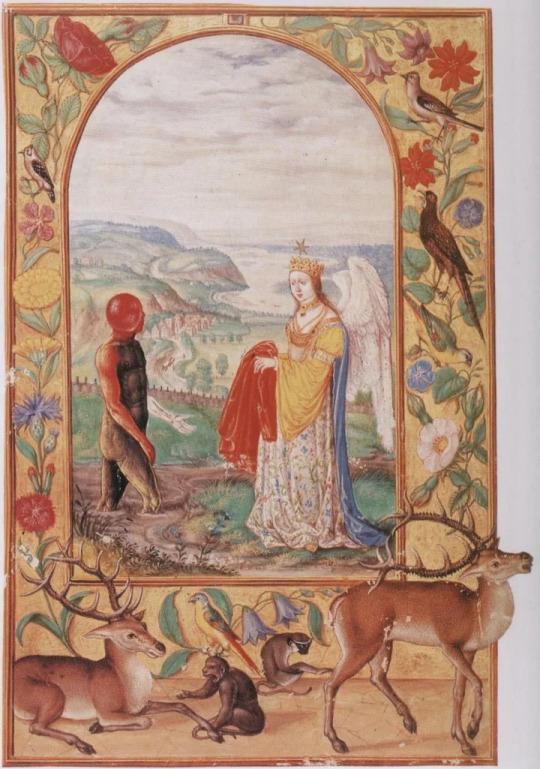
Sophia here has white angel wings as well. Who's been associated with that in Volume 9?

I bring this up to assert that I do think @aspoonofsugar is correct when she predicts that Weiss will have something to do with saving both Ruby and Jaune.
Mythcrafts notes that the very same Splendor Solis image alludes to Aristotle's quote "The Destruction of one thing is the birth of another.” Of course, that just references the ouroboros, which I've already talked about, but I do find it interesting that "destruction" is the "gift" of the gods to humanity that will be explored in Vacuo (since the relic of destruction is there). So, it would indeed be quite fitting for the characters to learn the value of destruction this volume--that death isn't the end of life, but a part of it.
134 notes
·
View notes
Text
A Dictionary of Alchemical Symbols
I was super flattered by all the positive comments and tags on my post about FMA:B’s alchemical symbolism. People seemed interested in learning more about alchemy, so I thought I’d post this here. This list is mostly paraphrased from A Dictionary of Alchemical Imagery by Lyndy Abraham, which is my main source. Brace yourselves, this will be long. (Disclaimer: The names and order of alchemical processes changes depending on the source. It’s a cyclical process, not a linear process. So I’m guessing at the order of the procedures.)
Abyss: Another name for Prima Materia, Chaos or the formless primordial matter from which the Stone is made.
Air: The androgynous, volatile, combined masculine and feminine principles. Its properties are hot and wet.
Alabaster: The White Stone, the material at the second stage of the work that can transmute metals into silver. It is purified and spiritual matter, body and soul (but not spirit yet).
Amber: Considered synonymous with gold, the product of the philosophical tree that represents the Philosopher’s Stone.
Androgyne: Mercurius and the Philosopher’s Stone, a union of male and female principles (i.e. Sun and Moon, sulfur and mercury, red and white), It is a synthesis of the hot, dry male aspect and the cold, wet female aspect. It represents the integration of male and female energies. It is therefore a union of opposites and a perfect being. It is sometimes represented by (red) roses and (white) lilies, which are symbols of the Red and White Tinctures. The symbol for Mercury (the planet) contains the symbols for both the sun and the moon, making it hermaphroditic. (Also called a rebis.)
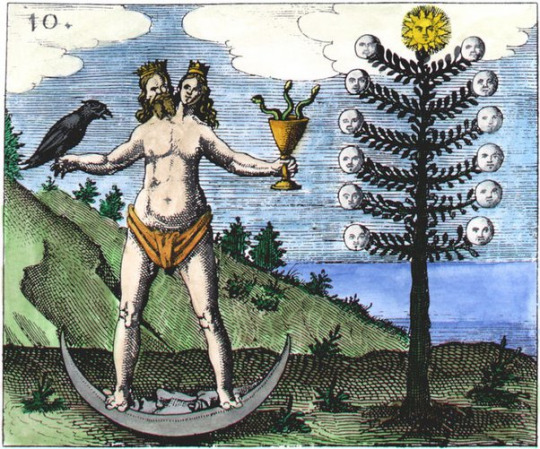
From Rosarium Philosophorum, redesigned by Johann Daniel Mylius
Angel: The volatile, spiritual, subtle matter of the Stone during sublimation.
Antimony: The substance of the Stone during the nigredo, black earth, the next stage up from lead.
Apollo: Represents the Red Tincture. The masculine principle, hot and dry, the rubedo stage.
Apple: The golden apple represents the fixing power of Sulphur on the elusive Mercury (represented by Atalanta).
Aqua ardens: “Burning water,” the universal solvent that dissolves matter into prima materia. Represented by Mercury.
Aqua regia: “Royal water,” a mixture of nitric acid and hydrochloric acid (sal ammoniac) that can dissolve gold and platinum. That makes it a form of the mercurial “burning water” that can reduce all metal to prima materia.
Aqua vitae: Ethanol, specifically distilled wine. It’s also a name for Mercury and for Quintessence, the catalyst of the work that “washes” the matter of the Stone to purify and whiten it. It’s the “water of life” that resurrects the dead matter, the essence of love and forgiveness.
Argent vive: Quicksilver, actual mercury (Hg), the feminine “seed” of metals that must be “married” to its masculine counterpart, sulfur.
Ash: The remains of the body when the subtle self (the soul) is removed during calcination. It is the white powder that the body becomes during the white stage, which is washed in mercurial water and tempered with fire. A phoenix rises from the ashes.
Autumn: The completion of the Great Work is symbolized by the philosophical tree bearing its gold and silver fruit. Trees bear fruit in autumn, making autumn the season of culmination.
Balm: A term for the Philosopher’s Stone in the form of a panacea, a medicine that can purify anything and cure any disease (including spiritual ones)
Basilisk: Mercury in its negative aspect, it represents endless hunger and self-absorption. It is the mercurial water in its destructive aspect, which “kills” base metal, reducing it to prima materia.
Bath: The mercurial waters of purification, which dissolves, cleanses, and resurrects the matter of the Stone. The breaking down and washing away of an old state of being, leading to rebirth; baptism.
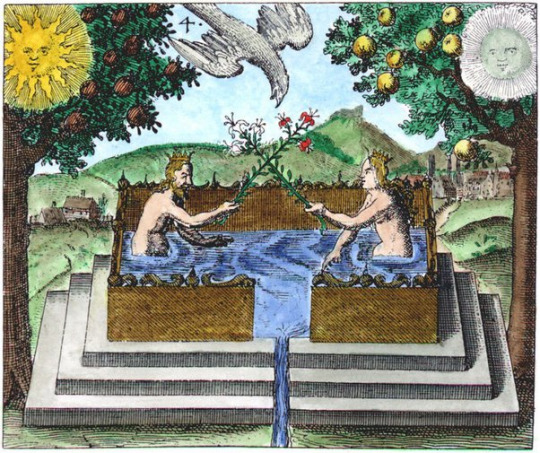
From Philosophia Reformata by Johann Daniel Mylius
Battles: Between a god and a dragon, or two dragons, or an eagle and a snake, a lion and a winged lioness, or similar; represent the alchemical lovers (Sol and Luna) in their impure state, as the “quarrelling couple.” Their fighting represents the violent chemical reactions that result of trying to force together the opposing forces of sulfur and mercury (or of the four elements), but eventually they reconcile and are married.

By Johann Daniel Mylius
Bed: The alchemical vessel during the “chemical wedding” stage.
Bee: Another symbol of the “mercurial serpent,” universal solvent. Its sting is a version of “killing” metals, destroying the old state of being. (Bees also transmute base matter in their process of creating honey.)
Beheading: The dismemberment of the King, the dissolution stage, leading to putrefaction and nigredo. It frees the soul from the body, so it can gain spiritual understanding. (The 8th engraving in The Ninth Gate.)
Binding: Binding Mercurius with cords represents fixation of the volatile, controlling the elusive and wily spirit of Mercurius so that he will help the alchemist. Nailing a serpent to a cross means the same thing.
Birds (flying): Represent volatile substances—vapors, fumes, spirits, souls, rising to the top of the alembic and falling as rain during the ablution stage.
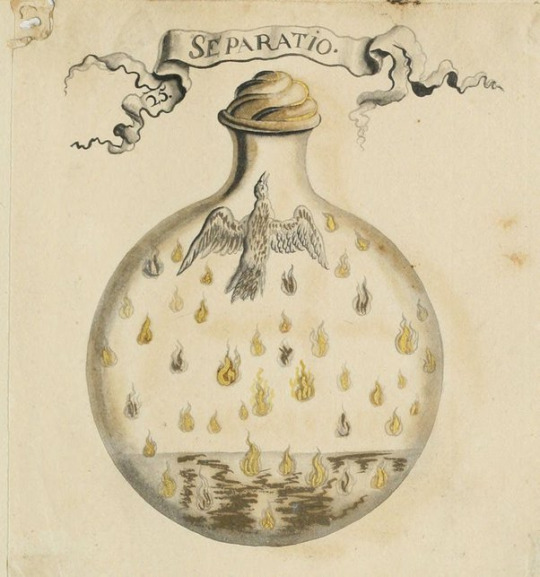
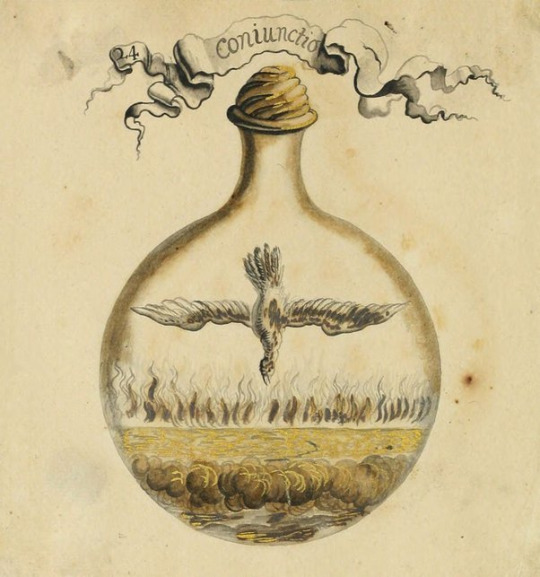
From The Crowning of Nature
Birds of Prey: The “amorous” birds of prey are a particularly violent symbol of the Chemical Wedding, the uniting of substances. They simultaneously copulate and cannibalize each other. Consumption represents taking the essence of the consumed into oneself, such as in communion or in the ouroboros symbol.
Bird of Hermes: A symbol of the Philosopher’s Stone, which must be hatched from an egg produced by the Chemical Wedding, raised, and tamed. It eats its own wings, representing the fixation of the volatile (i.e. it can no longer fly upwards). Its blood is the Elixir of Life.
Black: The nigredo, the death of the old state of being and the mortification of the body that paves the way for renewal and resurrection. The matter of the Stone during the nigredo is called “black earth,” and it lies at the bottom of the alembic. The soul descends into the Underworld and experiences the Dark Night of the Soul, and all the difficulty and pain that come with it. Symbolized by the crow or raven, the grave or tomb, the eclipse, beheading, coal, lead, and Saturn.
Blood: A symbol of the Red Tincture, the Philosopher’s Stone. If a “pure” being sheds blood, it cleanses “impure” beings of corruption. It is also the mercurial water that washes the matter of the Stone during ablution. The blood of the Green Lion nourishes the Stone during cibation. Staining white sheets with red blood (i.e. as in the loss of virginity, the gaining of sexual maturity) represents the rubedo following albedo.
Bronze/Brass: Both represent “white gold” (gold + silver), the raw matter of the Stone which must be cleansed of impurities. Identified with Latona (Leto), the mother of Apollo and Artemis (i.e. the sun and moon), and also with the Green Lion. It must have its “stains” washed away to become Gold and Silver (respectively).
Caduceus: The wand of Hermes, symbolizing the circulation of male and female energies (the serpents), and their reconciliation. The wand unifies them, and they entwine around it. Harmonizing unification of all opposites.
Calcination: Stage One. Heating the base metal to ash. This represents removing all the surface qualities of the self, putting oneself through “purifying fires” until one is reduced to prima materia. Self-judgement, acknowledging that you are not perfect, with a desire and determination to do better. Burn away the old self.
Castle: The alchemical vessel, sealed to prevent the substance of the Stone from being contaminated by outside forces, and to keep the volatile part from escaping. Its towers represent the athanor (furnace). The castle can also represent “impure” matter (i.e. the Green Lion, Latona). Also represents withdrawing to the inner self.
Chaos: The formless matter from which the world was made, the mass of prima materia at the beginning of the universe that contains all things, and from which all things come. The extremely dense ball of matter that was the universe until the Big Bang. Chaos is separated into the Four Elements, which are then united with each other in harmony.
Chariot of Phaethon: A name for the Great Work. This is because the Opus is cyclical like the wheels of a chariot and the sun’s course through the heavens. When Phaethon dies, Helios mourns in the form of an eclipse, representing the nigredo.
Chemical Wedding: The image of lovers, usually a king and queen representing the sun and moon, being married or having sex. One of the most important parts of the Work, the unification of opposites — sulfur and mercury, male and female, sun and moon, hot and cold, dry and moist, fixed and volatile, body and spirit. The lovers are wedded by Mercurius, the mediating principle who binds them together. The chemical wedding happens multiple times, becoming more “purified” each time – it begins as animals mating, and ends as the noble royal wedding of the King and Queen. The resulting Stone is the essence of pure divine love. Coagula is always followed by solve again, so often the lovers are shown in a coffin or grave, because the nigredo follows the chemical wedding. After that happens, soul and spirit unite in the albedo stage, and then they reunite with the now washed and purified body in the rubedo stage. Body dissolves into spirit, spirit coagulates into matter. Therefore, the knowledge gained from union with spirit (God) can be actively applied and made manifest in the physical world.
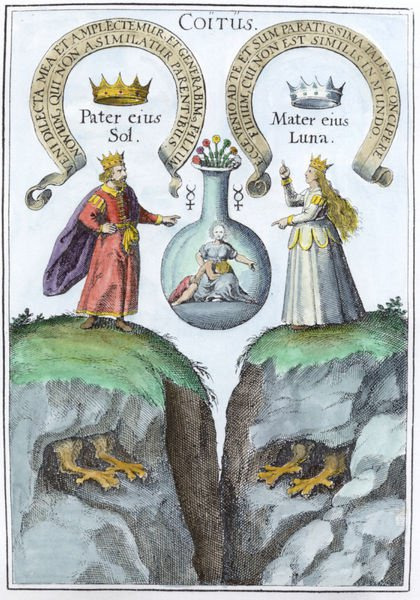
By Johann Daniel Mylius
Child: The Philosopher’s Stone when it is born from the chemical wedding of the Sun and Moon. He gestates in the belly of the wind, i.e. the soul in the volatile state. When he is brought to Earth and nourished, he grows up to be a spiritual tour-de-force that can raise the vibration of anything.
Child’s play: Another metaphor for the Opus, because the process is subversive, and because it’s stupidly simple once you actually understand how it works. The Opus is compared to making mud pies by pouring water on dust and then making “solid” objects with the resulting mud.
Cibation: Stage Seven. The newborn Stone is “fed” the White and Red Tincture, “milk and meat,” which are added to the vessel to re-infuse the Stone with life energy.
Cinnabar: Mercury sulfide (ore), which is bright red. Represents the color of the Stone in the final stages.
Circle: Perfection and eternity, the spiritual realm, the completed Work. With a dot in the center, it symbolizes gold.
Cloud: The vapor that rises to the top of the vessel during sublimation, the volatile state. The cloud is dark and made of argent vive (quicksilver), eclipsing the sun. During distillation, the cloud condenses into rain, which “washes” the stone during ablution.
Coal: Represents the nigredo, the black stage, the dead matter of the Stone.
Congelation: Fixation, crystallization, or freezing, the conversion of liquid into a solid state. Fixing the volatile spirit.
Conjunction: Steady, level heating of the mixture. Represents reconciling the polarized self, the first step towards integration of the Shadow. The “sacred marriage” or “chemical wedding” between mercury and sulfur unites them back into the same whole. Unification of opposites. The darkness becomes conscious. Coming to terms with oneself, self-acceptance, integration.
Copper: Metal that is almost perfect, but not quite. The state of being nearest to Gold; gold that still has a bit of darkness on it. It is still impure and not quite fixed. Once it “becomes shadowless,” it is Gold. Symbolized by Venus.
Coral: Represents the Red Stone, which grows in the mercurial water as coral lives in the ocean. Also represents the philosophical tree.
Cream: The white stage, albedo. After the chemical wedding, the souls of the dead king and queen rise to the top of the vessel the same way cream rises to the top.
Crocodile: The Mercurial Serpent in its most base and chthonic state, when it is dark and destructive.
Cross: A combination of the “passive” (horizontal line) and “active” (vertical line) forces of the feminine and masculine (respectively). Therefore, the synthesis of the male and female principles and the resulting unity of the volatile and the fixed. Also the four elements (clockwise from top: fire, air, earth, water) and Quintessence, the central point. (The hexagram has identical symbolism, being a combination of the signs for all four elements.)
Crow: The putrefaction stage, the nigredo or black stage that begins the work. The matter of the Stone is dissolved into prima materia and dies, so that it can be reborn.
Crown: A symbol of the spiritual perfection of the completed Philosopher’s Stone, which is represented as a king. The crown is a representation of the halo of light around the head of an enlightened person. The loftiness of alchemy is presented in regal terms – alchemy is called “the royal art,” gold the “noble metal,” and the final union of the male and female principles is the “royal wedding” between the philosophical King and Queen.
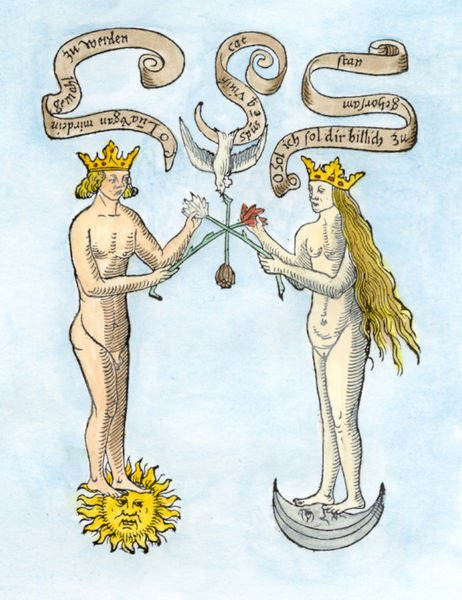
From the Rosarium Philosophorum
Crystal: A synonym for the Philosopher’s Stone at both the white and the red stage. Crystallization is also a word for coagulation, fixing the volatile.
Cupid: Another name for Mercurius in the form of “secret fire” or “burning water.” Cupid’s arrows of passion represent the universal solvent that reduces all substances to prima materia. The essence of love in the arrows refers to the higher nature of the Stone/elixir. Also a symbol of Mercurius as the mediator in the Chemical Wedding, who marries Sol and Luna.
Dawn: Represents the albedo stage, because the light of dawn is pale like moonlight, and it is followed by the blazing risen sun that represents the rubedo stage.
Decoction: Heating an ore or mineral, also extraction of the liquid essence of a substance by boiling.
Death: The nigredo stage of the Opus, during which soul is separated from the body and the body putrefies or is dissolved. Represents unenlightened consciousness and the rejection of the mundane self, being freed from the confines of one’s earthly body. An alchemist must metaphorically cast off the mortal coil without physically dying. Death is like a gate on a circlular path. You have to go through the gate, or you will never be able to continue around the circle. You’ll just stay stuck in place. To become immortal and continue forever around the circle, you must die, and cannot fear death.

From the Twelve Keys of Basil Valentine
Deer: Represents the soul. The “fleeing hart” represents Mercurius, specifically the flightiness of Mercurius, and also his role as the messenger and mediator between body and spirit. He is both a faithful servant (i.e. “servus/cervus,” deer) and an elusive and deceptive enigma that must be captured by the alchemist. According to Paracelsus, its antlers heal wounds.
Den: A word for the vessel during the nigredo — the serpent’s or dragon’s den, or spirits’ den.
Devil: A symbol of sulfur.
Devour: If animals or people devour each other, it usually represents an opposing state overcoming the other — such as the volatile (a winged creature) overcoming the fixed (the other animal), Saturn devouring the divine (mercurial) child, etc. Devouring is often a representation of solve, one substance or state being consumed by the other, but it’s also coagula in that it unites the fixed and volatile. The animals can also represent the earthly nature of man being destroyed. Something must die for a newer and purer thing to exist. Sometimes devouring is a metaphor for sex, a particularly violent rendition of the chemical wedding. It’s violent to symbolize the intense opposition of the substances.
Dew/Rain: The healing aspect of mercurial water. The blackened, putrefied matter of the Stone is washed in the dew and turns white (ablution). The dew falls like rain from the celestial spheres and reanimates the dead matter. “It ascends from the earth to the heaven and again it descends to the earth.” Precedes the second chemical wedding, when the purified soul is reunited with the body.
Diana: The matter of the Stone in the white stage, the White Tincture, the female principle, argent vive.
Dissolution: Stage Two. Dissolving the powder in (mercurial) water made from the condensed vapours from calcination. This represents self-awareness, dissolving your prejudices and old patterns, understanding the psychological roots of your behaviors. The first stage of Shadow work. Returning to the Abyss, the primordial waters, again and again and again. Purification by water.
Distillation and Sublimation: Stage Five. The process in which the volatile spirit is extracted from the impure body. It vaporizes (sublimates) and then condenses. Metaphysically, it’s katabasis, the necessary descent of the soul into base matter – “the way down is the way up.” You can’t ascend without having descended first. What Goes Down Must Come Up.
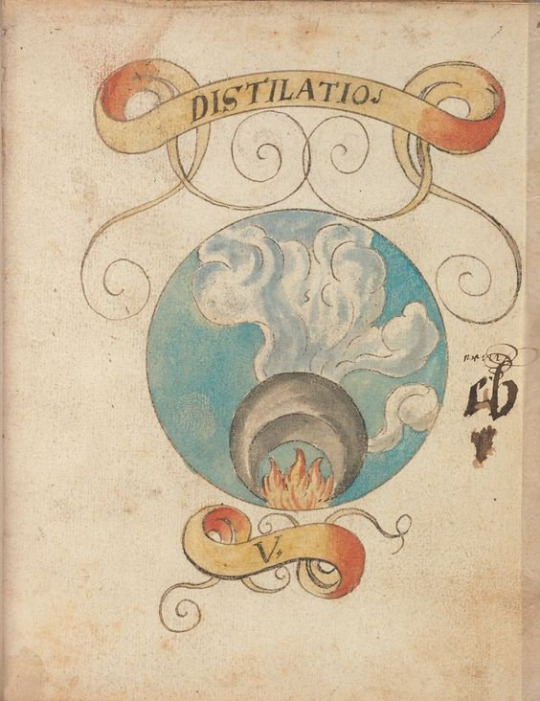
From The Crowning of Nature
Dog: A male dog represents sulfur while a female dog represents quicksilver. Two dogs having sex represents the most “primitive” form of the Chemical Wedding (which can also be represented by copulating dragons or lions).
Dove: A symbol of the albedo, the white stage, and purity following corruption. Also a symbol of Mercurius as the mediating force in the Chemical Wedding, uniting the forces of sulfur and quicksilver.
Dragon: Mercurius in his chthonic aspect as prima materia. Two dragons, one winged and one wingless, represent quicksilver and sulfur (respectively). They copulate, then kill and devour each other, then are entwined together around the caduceus in unity. Mercurial water is called “dragon’s blood” in its aspect as a universal solvent. It is the dragon that guards its horde of gold in the Abyss of a cave .The dragon represents the “base” self that the higher self must tame, represented by the dragon being slain by a solar hero (Apollo, Marduk, Siegfried, Beowulf, Harry Potter, etc.).

From The Ripley Scroll
Dregs: The impurities of the Stone that are left behind during dissolution and sublimation, that sink to the bottom of the vessel.
Dust: The purified body of the Stone during the albedo stage, which collects on the sides of the vessel through sublimation. (Also called ash, snow, or white foliated earth.)
Dye: A metaphor for the white stone turning red or purple. The Stone is “washed” in the Red Tincture, like dying cloth. Tyrian purple in particular is a metaphor for eternal spiritual perfection, because it is a permanent dye and rare. The Stone being stained with blood is the same metaphor.
Eagle: The White Tincture, another symbol of Mercurius during the albedo stage after sublimation. When paired with the lion, the lion represents the fixed state and the eagle represents the volatile state — if the eagle devours the lion, it’s a symbol of solve. The lion is devoured by the eagle to make it spiritual, and the eagle’s wings are clipped to make it corporeal.
Earth: Corporeality, the physical world, stagnation, fixation. The dense body of the Stone, represented by Saturn. (We live in the physical world, so the other elements are not their “true” selves, but perceived as correspondences that symbolize their true selves “through” the Earth element. It allows the other elements to “rest.”) Its properties are cold and dry.
East and West: Respectively, sulfur and quicksilver. Sulfur is dry and hot, quicksilver is cold and moist.
Eclipse: The solar eclipse represents the nigredo, when the impure matter of the Stone putrefies, death preceding rebirth. Described as a “black gate” that sulfur and quicksilver must pass through. The moon “dissolves” the sun. Symbolized by the Green Lion devouring the sun. (Also called sol niger. For the lunar eclipse, see sun and shadow)

From Philosophia Reformata, by Johann Daniel Mylius.
Egg: The vessel. Hatching of an egg is a metaphor for the creation of the Stone. The fire of the athanor is like a mother bird incubating her eggs.
Elements: Earth, Air, Fire, and Water. The Philosopher’s Stone must be made of all four elements in the right amounts to produce the perfect fifth element, Quintessence. Earth is cold and dry, Water is cold and wet, Air is hot and wet, and Fire is hot and dry. Earth can be mixed with water because they are both cold, Water can mix with Air because they are both wet, and then Air can mix with Fire because they are both hot.
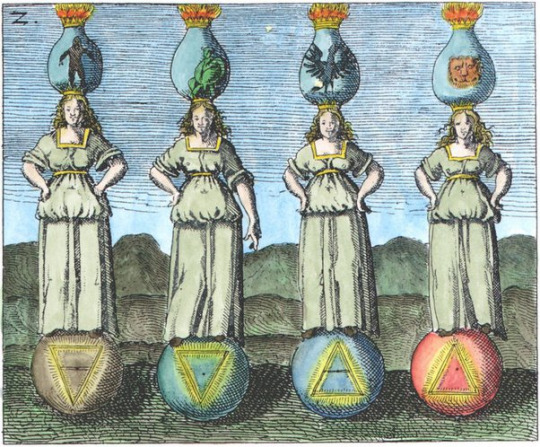
From the Viridarium chymicum
Elysium: A name for the white stage, a pure and beautiful garden of symbolic plants that immediately follows death.
Eyes: The rainbow “peacock’s tail” stage between nigredo and albedo.
Exaltation: Stage Eight. The material turns red, with all of its components fusing into one whole and becoming stable in the most intense heat of the furnace. The Stone has appeared. Once the ecstasy peaks, the body, soul, and spirit permanently fuse. Also called Fixation.
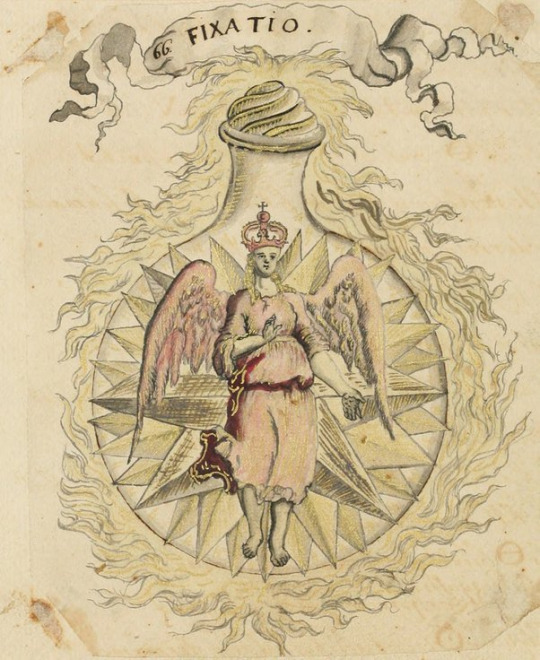
From The Crowning of Nature
Feathers: A bird eating its feathers symbolizes the dissolution that occurs after the chemical wedding (also symbolized by a child playing in a bath), Also a symbol of the “peacock’s tail” stage.
Fermentation: Stage Six. Permanently infusing life force into dead matter. The spiritual and base aspects of the self are united, and one is freed from superficial or “worldly” desires and concerns. The enzymes that cause fermentation represent the soul “quickening” the body. The material turns yellow and becomes gold. Add some gold to it to facilitate this change, like putting seeds into the earth. “Intoxicated surrender to one’s true inner self” (Richard Cavendish), seething emotions and ecstasy.
Field: Potential, the potential to “cultivate” the philosopher’s stone, in which the “seed” of the soul is sewn to be transformed into its realized potential, the flower. This happens through the course of the seasons—winter (black), spring (clear/white), summer (red), and autumn (gold).
Fire: The element, the essence of divine love, which causes transmutation. It is hot and dry, and inherently spiritual, a sort of microcosm of the Sun. The “secret fire” is purifying and transformative. The heat and intensity of the fire in the athanor increases as the Work progresses through the stages. Also represents the Divine Masculine. Symbolized by the Sun and Gold. In its impure form, as sulfur, fire is also individualization and the ego, which becomes consuming and desirous. Often conflated with mercurial water/argent vive, which “burns” and dissolves things.
Flood: Dissolution and putrefaction, with Noah’s Arc or a similar boat symbolizing the Vessel. The waters of the deluge drown and destroy everything, until they suddenly transform into the waters of life. The rainbow that follows the Flood is the Peacock’s Tail.
Flowers: Fully realized potential, resurrection, exaltation, rising from the depths of the Earth. (The stem is virile, the flower itself is elemental.) The rose in particular has mostly the same symbolism as the cross. Also a word for the powdery version of the body that is a result of sublimation. Also a symbol of the Philosopher’s Stone, the perfect substance. Flowers bloom as a result of Earth, Water (rain), and Fire (sunlight). White roses or lilies symbolize the albedo, golden flowers symbolize citrinitas, and red roses symbolize the rubedo.
Fountain: Purifying mercurial water, that generates all other metals. Same symbolism as the bath.
Fruit: Raw gold before it is transmuted into the Philosopher’s Stone. If the fruit putrefies in the ground, then its seeds will sprout into new trees. The Philosophical Tree bears gold and silver fruit representing the Sun and Moon. Bearing the fruit is a symbol of increasing spiritual awareness, and eating the fruit represents gaining that spiritual knowledge. Sometimes the golden fruit is specifically the Apples of the Hesperides, guarded by the dragon.

From Compendium Alchemyst by Johann Michael Faust
Furnace: The athanor in which the alembic or Vessel is heated. It contains “philosophical fire” (the soul), which purifies the matter in the Vessel. It causes suffering but also removes impurities. You have to suffer in the fire to be cleansed, and rise from it like the phoenix.
Garden: The Vessel, in which the philosophical tree grows. Sometimes also a rose garden, with red and white roses. The blooming of the roses represents the attainment of spiritual wisdom.
Glass: The Vessel. When the alchemical couple (Sol and Luna, or sulfur and quicksilver) die and enter the putrefaction stage, they are “shut in a glass.” The vessel can be symbolized as a glass house, glass prison, or glass coffin. Making glass is also a metaphor for the fixation process, because the volatile liquid crystallizes into hard glass.
Glue: The medium by which Sol and Luna are joined together during conjunction, that which officiates their Chemical Wedding. A form of Mercurius, the mediating soul that unites the body and spirit. Usually symbolized as a dove. Also symbolized as gum or resin from the philosophical tree.
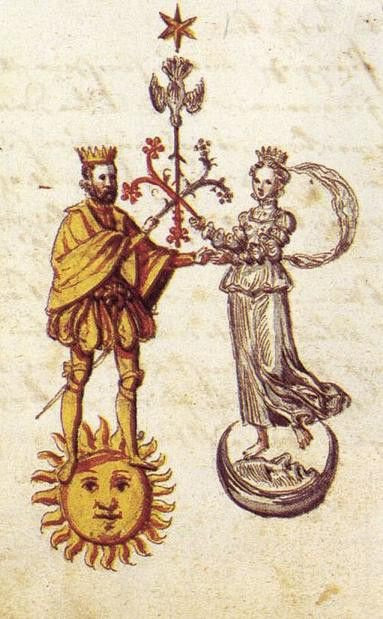
From the Rosarium Philosophorum
Gold: A pure, condensed form of the solar force and the Divine Masculine, and the ultimate goal of alchemy, representing spiritual perfection. It is the microcosmic Sun. It can “endure the trials of fire” (i.e. it has a low boiling point). All metals were thought to contain the potential to “ripen” into it, under the right conditions. Figuratively, this means that all people have the potential to become pure spiritual beings. The golden soul is one that has died and been resurrected as a purer thing, whose spirit has become fixed, and who has therefore attained a kind of earthly divinity.
Golden Fleece: A symbol of the Philosopher’s Stone. The quest for the golden fleece represents the alchemists’ quest for the Stone. Also a term for a supposed book made of sheep vellum that details all the secrets of the Great Work.
Grain: A term for the “seed” of metals, which grows into Sol and Luna (gold and silver). The Stone is also compared to grain or corn that has to “die” before it can bear fruit. “Purple grain” is the Red Tincture.
Grapes: Prima materia, the raw material of the Stone. Grape juice or wine represents the mercurial water of dissolution. A grapevine can also represent the philosophical tree, with the red fruit being the Philosopher’s Stone.
Grave: The Vessel during the nigredo stage, when the matter of the stone dies and putrefies. The dead bodies of the alchemical lovers are shown in a tomb or coffin.
Green: The color of the maturing Stone, after it has been born. It is the color of fertility and growth, so it represents the Stone’s capability to multiply itself and cause the “seeds” of metals to “mature” into gold and silver. It also represents the generation of the Stone after the Chemical Wedding.
Green Lion: Raw antimony ore (stibnite), “unclean” or “impure” material of the Philosopher’s Stone. Prima materia at the earliest stage of the Opus. The volatile mercury (spirit) is extracted from it. Associated with Latona (Leto, from whom Apollo and Diana as the Sun and Moon are born). It is green because the vital essence of fecundity comes from it, but also because it is an early and “immature” form of the Stone (like unripe fruit). Represents Mercurius in its form as a solvent: the lion eats the Sun, causing the nigredo and dissolution. After it is dissolved into prima materia, the “seed” can grow. The Green Lion also represents Mercurius as the “glue” that marries the Sun and Moon.
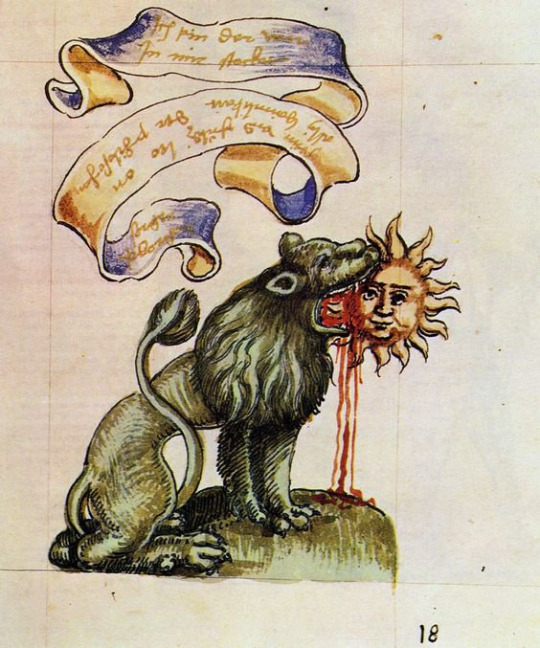
From the Rosarium Philosophorum
Griffin: A symbol of argent vive/quicksilver, the female principle. The feminine equivalent of the red lion. They fight each other, symbolizing the Chemical Wedding at its most early stage. (Combines the volatile eagle with the earthly lion.)
Halcyon (Kingfisher): A symbol for philosophical mercury, which is supposed to be sky blue. It is a universal solvent, able to destroy and then revitalize anything.
Harvest: The completion of the Opus and attainment of the Stone. The Great Work is often compared to the cultivation of a tree or a flower.
Head: The vessel or alembic, also symbolized by a helm. The vessel itself is a metaphor for the human body, and the real transmutation takes place in one’s head (i.e. mind). A person with black feet, a white body, and a red head is a symbol of the Opus. A severed head is a symbol of nigredo and dissolution, the separation of the soul from the body.
Heaven: The subtle matter of the Stone, the volatile vapor at the top of the alembic (as opposed to the “white foliated earth” at the bottom). “It ascends from the earth to the heaven and again it descends to the earth.” Quintessence is also called “heaven” because it is a perfect substance and it is bright blue.
Hell: The black matter of the Stone during the putrefaction stage, which is destroyed by fire (or “secret fire,” mercurial water). This stage is the descent into the Underworld or Tartarus.
Hermes’ Seal: The seal made of a special clay that keeps the alchemical vessel closed and airtight. The sealed vessel functions as an isolated cave or sanctuary in which one can seek enlightenment.
Hermes’ Tree: The philosophical tree, which must be tended by the alchemist and nourished with mercurial waters and then harvested. Another symbol for the Philosopher’s Stone.

From Philosophia Reformata, by Johann Daniel Mylius
Hermes Trismegistus: The legendary inventor of alchemy, said to be an incarnation of both Hermes and Thoth. Called “thrice-great” because he was a king, a mage, and a priest. Said to have written the Emerald Tablet and the Corpus Hermeticum.
Hesperides: The garden in which the philosophical tree grows. The Golden Apples of the Hesperides are another symbol for the Philosopher’s Stone.
Homunculus: An artificial human created in an alembic. Also a symbol of the Philosopher’s Stone in its infantile state. Represents the birth of the divine child inside one’s own soul. The Stone is figuratively a “baby” that must be gestated and raised, both in the alembic and spiritually in one’s soul. (i.e. You are reproducing God’s creation of yourself in a microcosm.)
Honey: Another name of mercurial water, in its aspect as a healing agent instead of a “burning” solvent. A symbol of the Elixir of Life and the panacea, because it is a sweet gold liquid.
House: The Vessel. It’s made of glass, shaped like the squared circle, and “sweats” (condensation).
Inversion: Alchemy constantly involves reversal — flipping between states of matter, releasing the soul from the body and then bringing it back down into the body, dissolving a substance down into prima materia and then reforming it. Descend before you can ascend, go backwards to go forwards. As above, so below. This is why Mercurius is dual-natured.
Inverted tree: The upside-down philosophical tree has its roots in heaven, which means that its nourishment comes from the Divine (Mercurius), and it “returns” to the earth.
Iron: Represents Mars, action, virility, and violence. If one can separate the virile warrior component from its corporeality, it can become Gold. Iron is “fixed” Sulfur. When treated by Water (female principle) and Fire (male principle), it becomes “purer” Steel. The production of steel is therefore a microcosm of the Great Work.
Jackdaw: Being a corvid, it’s another symbol for the nigredo stage, death and passage through hell.
Jupiter: Represents the metal tin, and the color gray. Tin is “imperfect” but takes only a little bit of work to become perfect (i.e. turn to gold). Also represents fire as in actual fire (not “secret” or “philosophical” fire). Zeus bringing Ganymede to Olympus in the form of an eagle represents sublimation. He also turns into a shower of gold to visit Danae — Jupiter easily turns to gold.
King: The matter of the Stone, as well as the hot and dry male principle — sulfur in its impure state, gold in its pure state. He is the Sun, and must be “married” to his female counterpart, who represents mercury and the Moon. He represents the conscience and the Divine Masculine. The King is both the philosophical child and its father (implied to be the same being). He dies and then is resurrected. His drowning in the ocean or a bath is a symbol of dissolution, followed by a gentler washing of his body, then he is married to the Queen. The resulting child is the Philosopher’s Stone, who also grows up to become a King.
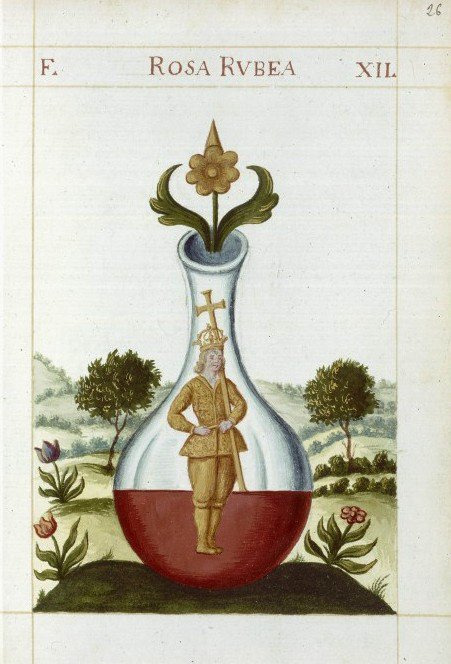
From Pretiosissimum Donum Dei
Labyrinth: The dangerous and confusing process of the Great Work. The labyrinth is full of illusions, and only with divine inspiration can one make one’s way through.
Latona: An imperfect or impure version of the Philosopher’s Stone, represented by bronze or brass (or copper). Similar in nature to the Green Lion. The blackened body of the stone preceding the albedo stage, that must be washed to remove its impurities. She is both metallic ore and the bowels of the earth from which it comes. (The name “Latona” comes from Leto, the mother of Apollo and Artemis, i.e. the mother of gold and silver.)
Laundry: Ablution, washing the Stone to cleanse it of its impurities during the white stage. The stained sheets represent the impure matter, which must be washed so that they will turn pure white. (When the sheets are later dyed red or purple, it represents the rubedo.)
Lead: Prima materia, the raw material that is made into the Philosopher’s Stone and also transmuted by it. The former is “philosophical lead,” the matter of the Stone during the nigredo stage. Represented by Saturn, who can be interpreted as an “aged” Mercurius. White lead is “purified” lead in the albedo stage. Symbolizes the chaotic and melancholic state of the soul after having been separated from itself. (also called Adrop)
Leprosy: The “imperfection” of metals, i.e. lead, copper, tin, and iron are just “diseased” gold and silver. They need “medicine” in the form of the panacea or Philosopher’s Stone. (also called rust)
Lily: The White Tincture and White Stone, the matter of the Stone during the albedo stage. Symbol of purity, perfection, the Moon, and the female principle. Therefore it also represents silver, quicksilver, and Luna/the Queen. It’s paired with a red rose, which represents the male principle. (A white rose symbolizes the same things.)
Lotus: A circular flower with a vertical stalk on horizontal water, therefore the same meaning as the ankh symbol—life, rebirth, resurrection, eternity.
Lute: A kind of clay used to seal the vessel/alembic. It’s made of various things — glue, flower, herbs, honey, egg whites, wax, resin, vitriol…
Magistery/Magisterium: A name for the Great Work. Means literally, “quality of mastery.”
Magnesia: Refers to several substances, all symbols for Terra Alba, “white foliated earth.” Also a name for Mercurius in the form of Quintessence.
Marble: A symbol of the White Stone, which is acquired during the albedo state.
Mars: Represents the metal iron, and the color red. Follows Venus in the Opus, and is associated with the “peacock’s tail” stage. He symbolizes the violent, impure form of the Divine Masculine, symbolized by the Red Lion.
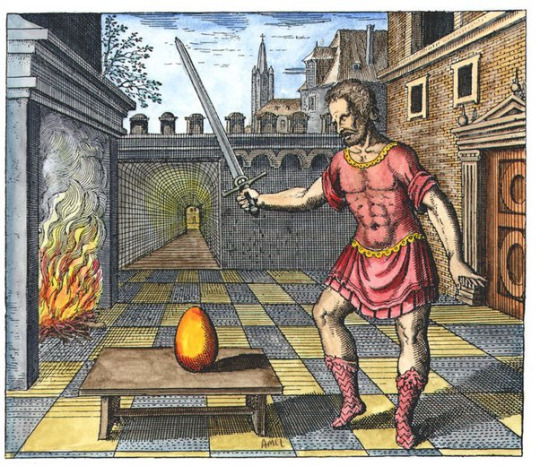
From Atalanta Fugiens
Medicine: The Philosopher’s Stone in the form of a panacea. It can supposedly cure any disease, and also transmute “diseased” metals (copper, iron, tin, lead) into gold and silver. The idea of a panacea is more metaphorical, curing “diseases” of the soul and transforming human beings into enlightened and divine versions of themselves. In short, it raises the vibration of anything it comes in contact with.
Melancholia: The state of mind that accompanies the suffering of the nigredo stage. It is the initial terror and sadness that you experience upon confronting your Shadow. You end up in the “nox profunda,” the deep night or dark night of the soul, a dark pit of the Underworld which it feels like you will never escape.
Menstruum: Mercurial water, the universal solvent. Called the “blood of the green lion.”
Mercurial water: The universal solvent, which dissolves metals and other matter into the prima materia. Symbolized by a lion or a serpent, and also by water (floods, dew, fountains, rain, tears, the ocean). It first “burns” and destroys everything to “kill” the old state of being, but then transforms into the water of life, washes and revitalizes it. (also called alkahest)
Mercurius: The ultimate agent of transmutation, the purified prima materia and the divine spirit within matter. Both the Philosopher’s Stone, and the Opus that produces it. Sometimes Mercury is described as “philosophical water,” or as fire, or as air or vapor (spirit, soul). It is prima materia, the source of metals, and also their potential to turn to gold. It is the primordial “mother” of the Philosopher’s Stone and also the child, the Stone itself. It is self-begotten, self-generative, self-destroying (i.e. the ouroboros). It is the universal solvent of death, and the animating force of life. Hermes is dual-natured and a synthesis of all opposites. He is both light and dark (i.e. celestial and chthonic) and is not tainted or corrupted by his engagement with darkness. He dissolves and coagulates, creates and destroys, kills and revives. He is an elusive trickster, but also a helpful ally. Alchemical Mercury is also a hermaphrodite, both male and female. Mercury is the spirit that unites body and soul, and weds the Red King and White Queen. Since Hermes is the messenger god who transfers information between the human and the divine, and brings the soul between life and death, he is also a mediator between the mundane self and the Higher Self. Mercurius is also a summary of the entire alchemical process. “Binding Hermes” means making his volatile nature, fixed. First he is the dragon or serpent, then the green lion, then the white eagle. Finally, Hermes’ association with commerce relates to the alchemical production of gold. (Also called Azoth, aqua divina, aqua permanens, aqua regia, aqua ardens, aqua vitae) (Note: Mercurius represents the Stone, not actual mercury. For actual mercury, see quicksilver.)
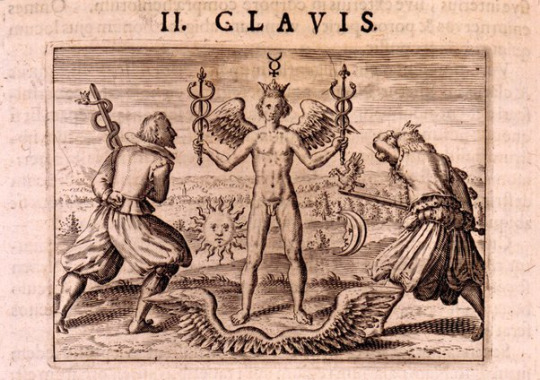
From the Twelve Keys of Basil Valentine
Metamorphosis: A word for transmutation, changing states of matter or states of being. Also, Ovid’s Metamorphoses were referred to as analogies for the Opus by alchemists.
Milk: The pure and spiritual version of mercurial water, extracted from the green lion ore. The White Tincture, which can transmute metal into silver. It nourishes the baby Philosopher’s Stone during the cibation stage.
Mirror: “Divine Spirit,” observing the self, becoming the most divine version of oneself through self-observation and Shadow work.
Moon: Silver and quicksilver/argent vive (actual mercury), the female principle. Also the White Tincture and White Stone in the albedo stage. Luna is married to Sol, the King. Her properties are cold, moist, and receptive to his hot, dry, and active. She is the Divine Feminine, and represents, the imagination, dreams, emotions, intuition, the subconscious, the changeable and volatile, the energetic, the soul. The subconscious is “cleansed” during the white stage. Cold moonlight represents the half-enlightened conscience of the albedo stage. Associated with solve, dissolution, making the mundane spiritual.
Mountains: A symbol for the source of prima materia. To obtain it, the alchemist must climb a mountain and extract the juice of a magic herb that grows on it. Sometimes there’s two mountains, one for the masculine “seed” and one for the feminine one. Going into the mountains can also be a metaphor for isolating oneself to gain spiritual awareness.
Multiplication: Stage Nine. Another sacred marriage/copulation between the Red King and the White Queen, so the Stone can become “fertile.” The Opus repeats itself again and again in rapid succession, with the Stone constantly dissolving and coagulating to create more of itself.
Nest: The Vessel, as a container for the “egg” or “chick” of the Bird of Hermes.
Night: The nigredo, the first stage of the Opus. It’s the Dark Night of the Soul in which the body dies and putrefies, and then is dissolved. The soul experiences a descent into the Underworld.
Oak: The philosophical tree. Also the vessel or athanor, when hollow.
Orphan: The Philosopher’s Stone, because its “parents” (the King and Queen. Sol and Luna) must die so it can be born. The alchemist becomes its foster parent and raises it in their place.
“Our” [substance]: Alchemists use the word “our” to refer to spiritual/metaphysical symbols represented by substances. So, “our mercury” isn’t Hg, it’s the feminine principle of nature. “Our sulfur” is the masculine principle of nature. “Our gold” is the perfect state of being, and not actual gold, Au. “Our [symbol]” refers to the metaphorical thing the symbol represents, not the symbol itself. It was never about making actual gold. If you think it is, you’re missing the point.
Ouroboros: The universe and the Great Work. The Ouroboros is and encircles all things, and thus represents the Principal of Mentalism. It is the circle of life — life returns to that which generated it, and supports other life. It creates itself, and also destroys itself (since it bites its own tail), and therefore is also primordial chaos and prima materia. All things come from it and return to it, and it continues in an eternal cycle. It represents the cyclical nature of the Opus, and also the eternal process of solve et coagula – killing itself, resurrecting itself.
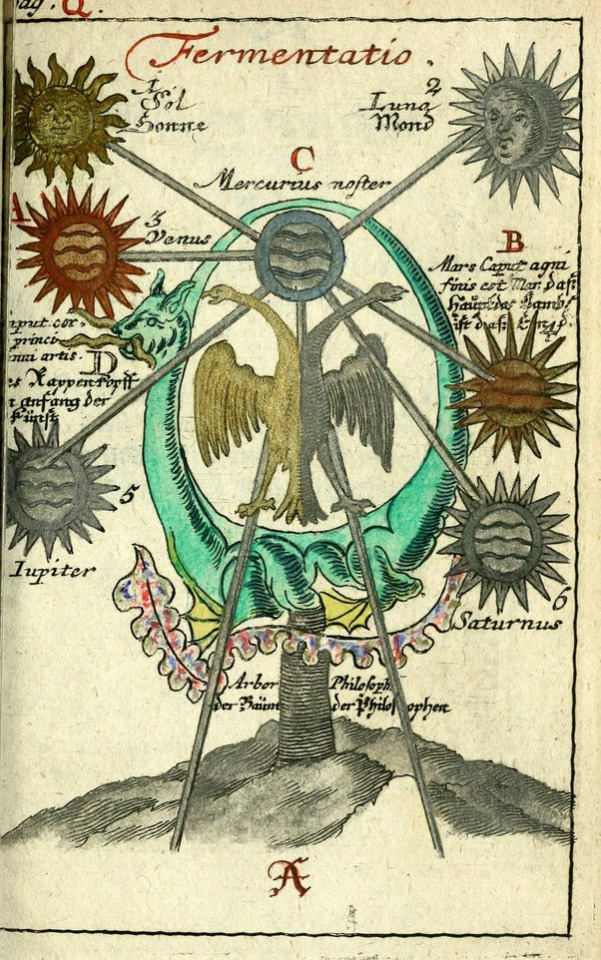
From Compendium Alchemyst
Paste: The whitened matter of the Stone. During the fermentation stage, another chemical wedding happens between the Stone’s purified soul and this white purified body, which is compared to making bread. The paste is bread dough.
Peace: The state when the opposing forces of the Opus (male and female, sulfur and mercury, fixed and volatile, body and soul, etc.) stop fighting with each other and are united in the chemical wedding. This is why a dove officiates the wedding. Signified by the “peacock’s tail” stage.
Peacock’s Tail: The stage between nigredo and albedo, when the stone is washed with mercurial water during ablution. As the blackness is washed away, it is replaced by the iridescent colors of the rainbow. Instead of white splitting into many colors as in a prism, the many colors coagulate into white. Eating the peacock’s flesh integrates the rainbow colors into the single white color, a state of purity and wholeness.

From the Ulrich Ruosch Manuscript
Pearl: A symbol of the ablution stage, because the drops of condensation that result from distillation look like pearls. Also a symbol of the White Stone.
Pelican: A symbol of the cibation and multiplication stage. The pelican bites her own chest to feed her hatchlings with her blood, like the Bird of Hermes feeding the baby Stone with the Red Tincture. (Pelicans don’t actually do this, but were believed to, and were considered symbols of Christ for their sacrifice of their own blood for their young.) Also a particular type of vessel.

From the Ulrich Ruosch Manuscript
Philosopher: An alchemist. This alone is an indication that alchemy isn’t about science, but about attaining spiritual wisdom. Hence why alchemical substances or symbols are described as “philosophical” – it’s not the literal, physical thing that matters, but the metaphorical or spiritual thing. Alchemy really happens in the mind, not in the laboratory. The alchemists sought to discover how the world works on both a physical level and a spiritual level, simultaneously.
Philosopher’s Stone: The ultimate goal of alchemy, substance that can supposedly perfect all imperfections (which I interpret to mean, it raises the vibration of anything it comes in contact with). It is the substance of divine love and creative power, a crystallization of the essence of life. It can supposedly turn lead into gold, heal all illnesses, and do various other miraculous things. It is created by reproducing God’s creation of the world in the microcosm of the alembic. It is supposed to be a perfect balance of all four elements, and is born from the divine union of the archetypal male and female forces of the universe. It is supposedly created by reproducing God’s creation of the world in the microcosm of the vessel, beginning with primordial first matter (prima materia) and shaping it into sulfur and mercury, which then “marry” and combine to produce the Stone. Honestly, seeking the Philosopher’s Stone is like going on a long Epic Quest for some magical unattainable object (like the Holy Grail or El Dorado), only to discover that It Was Inside Of You All Along, but the journey itself facilitated your character development to make you a better version of yourself. The point was always the journey; the Philosopher’s Stone is a natural result of having undertaken the Opus at all.
Philosophical Child: The newborn Philosopher’s Stone, the result of the Chemical Wedding. The final part of the Opus is compared to raising a child, who is fed and nourished by the alchemist. He grows up into a king and a magician who has power to “vanquish every subtle thing and penetrate every solid thing,” cure all disease, transmute all metals.
Philosophical Mercury: Prima materia or Mercurius. Not the same as “vulgar mercury” or quicksilver (Hg).
Philosophical Tree: Represents the Philosopher’s Stone, the process of the Opus, and also the “expansion of consciousness” that results from it. The process of making the Stone is compared to the cultivation of a tree, and the Stone multiplies itself like a tree bearing fruit. The tree grows from a seed, the “seed” of metals within prima materia, is nourished by rain, and it finally bears gold and silver fruit that represent the Sun and Moon (as well as “perfect” metal). This is all a metaphor for the spiritual growth of the soul towards its ultimate divine form. Sometimes the tree is instead a flower (like the red roses and white lilies, representing the Red and White Tinctures), or a magic herb. Sometimes there are two trees, a gold solar tree and a silver lunar tree. Sometimes it has seven branches to represent the seven planets, making it a symbol for prima materia. Sometimes it grows on an island in a sea of mercurial water, sometimes it grows on a mountain of prima materia, and sometimes it grows in a magical garden of wisdom.
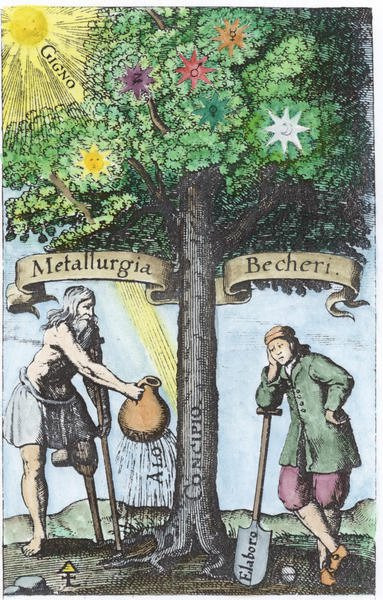
By Johann Joachim Becher
Phoenix: Resurrection, the Philosopher’s Stone in the red stage. Fire in its purest and most spiritual form. Represents rubedo and the multiplication stage, when the Stone/elixir replicates itself. It has been resurrected, and has the power to resurrect itself and others indefinitely.
Poppy: The rubedo, the red color of the Stone or Red Tincture in the final stage.
Pot: The vessel, in this case described as being made of clay and filled with dung to act as a container for the first Chemical Wedding and the nigredo, becoming “pregnant” with the seed of the Stone.
Prima materia: “First matter,” the primordial essence of all things. Alchemists believed that everything was made out of an original substance from which the world was made, and that if you could distill and refine matter (metal, for instance) all the way down into this original substance, you could reshape into whatever you wanted. i.e., reduce lead down to prima materia and then reform it as gold by putting a “seed” of gold into it. Hence “solve et coagula,” dissolve and reform. Symbolically, prima materia represents the soul in its original state. You have to be able to break down the person you think you are, until you are left with nothing but the true core of your being. In Jungian symbolism, it is also the subconscious mind, a dark and scary place that is also the source of inspiration and growth. Prima materia is compared to dirt or dung by alchemists, because it is supposed to something normal and mundane that is found everywhere, and dismissed as worthless by the uninitiated. There are so many symbols related to it, especially water, snakes, earth, seeds, blood, Saturn, chaos, and lead.
Prison: The vessel during the putrefaction stage. The alchemical lovers, Sol and Luna, are imprisoned in it and left to die while their souls rise to the top of the vessel.
Projection: Stage Ten. Using the Stone to transmute other metals, completing the cycle. The Stone raises the vibrations of everything it comes into contact with.
Proteus: The shapeshifting sea god in Greek mythology, a symbol of Mercurius in its volatile state, which takes on many confusing forms and has to be held down until it is tamed and takes its original shape. The sea that Proteus lives in is pirma materia.
Purple: Sometimes used to describe the Philosopher’s Stone and Tincture in its final rubedo state, instead of red. This is because Tyrian purple is very rare and hard to get, must be extracted from snails, and is only worn by royalty. It is the color of attainment, spirituality, and mastery.
Putrefaction: Stage Four. Subjecting the material to a moist heat and letting it turn black. It is now a dead thing with all of its characteristics stripped from it, prima materia. Vapor (the life-spark) leaves it. Represents spiritual death, melancholy, dejection, suffering. The Dark Night of the Soul. Death of the old self paves the way for a new mode of thinking, initiation.
Queen: The matter of the Stone during the albedo. The cold and moist female principle — mercury (Hg) in its impure state, silver in its pure state. She is the Moon, and must be “married” to her male counterpart, who represents sulfur and the Sun. She is also mercurial water in its role as the replenishing water of life or nourishing milk, the White Tincture. She represents the subconscious, perception and the imagination, “higher” spiritual and moral faculties, and the Divine Feminine.
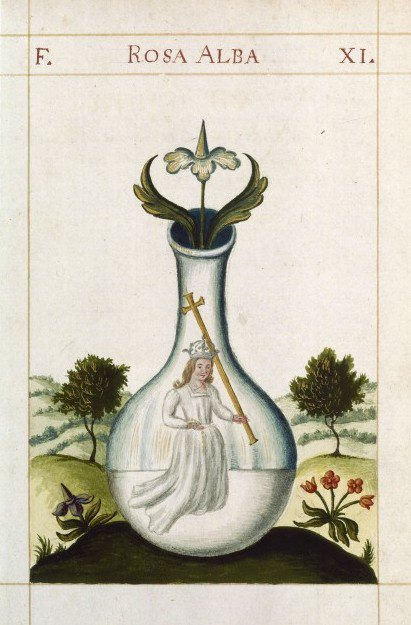
From Pretiosissimum Donum Dei
Quicksilver: Mercury (Hg). The agent of the feminine principle, the “unripe” form of silver. Cold, moist, receptive feminine “seed” of metal that unites with Sulphur to form the Philosopher’s Stone. It is made of Earth and Water. Confusingly, it can also be a symbol for Mercurius in its “slippery” and elusive form. In Paracelsian alchemy, it represents the spirit, the animating force of life. Sometimes also a synonym for prima materia, represented by the dragon or serpent. It has the power to dissolve or vaporize fixed matter. (Also called argent vive.)
Quintessence: (also called Azoth), the fifth element and the result of unifying the other four. It is what the Stone is made of, and in liquid form it is the Elixir of Life. It is purified prima materia, an inherently spiritual substance. Believed to be a panacea. (I interpret it as being able to raise the vibration of anything it comes in contact with.) Symbolized by a crowned maiden, or by Mercurius.
Rainbow: The peacock’s tail stage, which occurs during ablution, when mercurial water falls like rain onto the black dregs. The many colors of the rainbow integrate into white, representing the calmness and receptiveness of the soul.
Raven: Nigredo, when the impure matter of the Stone dissolves and putrefies in the bottom of the flask. It is the initial, death stage of the Opus.

From the Ulrich Ruosch Manuscript
Red: The rubedo, the final stage of alchemy in which the white matter of the Stone turns crimson as the spirit merges with the body. It crystallizes and becomes fixed. Self-actualization and resurrection, the attainment of spiritual enlightenment. Symbolized by blood, red roses, rubies, coral, gold, the Sun, the phoenix, and the King.
Red earth: A name for the base matter of the Philosopher’s Stone, which is dissolved into prima materia and then refined into the Red Stone and Red Elixir.
Red Elixir: The Philosopher’s Stone in liquid form, as a panacea. It can cure all diseases, transmute metals into gold and silver, raise the dead, make old people young again, give strength to living beings, etc. It is “fed” to the baby Stone during the cibation stage, so that the Stone will be multiplied by itself and produce more of itself. (Also called the Red Tincture)
Red Lion (or Dragon): Represents sulfur and the planet Mars. It’s Sol, the masculine principle, in its “impure” state at the start of the Opus: the wild, animalistic, instinctive part of the soul that needs to be “purified” by being defeated. It is “terrestrial man,” the King at his most mundane. It burns everything that it comes into contact with.

From Clavis Artis
Red powder: The Stone in powdered form. It’s cast over or mixed with metal to transmute it, and taken as a medicine.
Red Sea: Another symbol for prima materia and mercurial water, the source of life and death that both dissolves everything and revitalizes it. The crossing of the Red Sea in Exodus is a symbol for how its waters will destroy the uninitiated and show the way forward to the enlightened. It also can be “parted” into four elements.
Refine: Purifying a substance by repeatedly dissolving and coagulating it with water and fire, which slowly removes its defects. This is a metaphor for raising the “vibration” of the soul, from a lower, mundane state to a higher, spiritual state. The soul must endure many trials (fire and water) to reach this state of spiritual purity, until it is pure enough to permanently fuse with the spirit of God and become divine-in-human. Becoming “gold” is to be able to withstand the heat of any “fire” (gold has a very high melting point) and host the Sun within oneself.
Return: The “process of return” is a name for the Great Work, because it is a cyclical process of repeated “solve et coagula.” The matter of the Stone must return to prima materia, the four elements to quintessence, the soul to the perfected state that it was in at the creation of the world, the world itself from the dismal “Iron Age” to the ideal “Golden Age” of the distant past.
River: Another symbol of mercurial water. There are two rivers, one male and one female. The female one dissolves, and the male one coagulates. When the two rivers flow together into a single river, it represents the Chemical Wedding. When the rivers dry up, it represents the crystallization of the Stone in the dry, solar rubedo stage.
Rock: A synonym for the Philosopher’s Stone, for the mountain of prima materia, and also for the vessel in which the Stone is made.
Roots: The four elements are the “roots” of the philosophical tree, from which the Philosopher’s Stone grows.
Rose: The rubedo and the Philosopher’s Stone, the completion of the Opus. A blooming rose represents attaining wisdom and enlightenment. If a red rose is paired with a white lily (or a white rose), it represents the Red Tincture and the King/Sol.
Ruby: The Red Stone. The “celestial” ruby has the power to transmute all metals and make anyone enlightened.
Sable robe: Black garments (mourning clothes) are another symbol of the nigredo, the dark night of the soul.
Sal ammoniac: Ammonium chloride. It’s a symbol of the White Tincture, the matter of the Stone during sublimation, after it has been dissolved. It’s represented by the eagle. It’s also an ingredient in aqua regia, because it produces hydrochloric acid when dissolved.
Salamander: Sulfur, the hot and dry male principle and the masculine “seed” of metals. Although salamanders are amphibious creatures, they were believed to be able to withstand flames, hence why they’re associated with fire. Paracelsus named them as fire elementals, implying that (in this context) salamanders are a type of spirit. Also represents the Philosopher’s Stone and Red Tincture, similarly to the phoenix. The salamander’s blood is the panacea.

From Atalanta Fugiens
Salt: Represents the body and the state of fixation in Paracelsian alchemy, with mercury being the spirit and sulfur the mediating soul. Traditionally, though, it’s a synonym for ashes and white foliated earth, another symbol of matter of the Stone in the white stage.
Sand: Another version of the bath, but the Vessel is placed in heated sand instead of water. Red sand is also a symbol of the raw matter of the Stone.
Sapientia: Divine knowledge and wisdom, which is what the alchemist ultimately hopes to obtain. It is the divine feminine principle, represented by the Queen. Wisdom is personified as a beautiful woman who is an emanation of God. She is the active ingredient in the panacea.
Saturn: Represents the metal lead, and the color black. Also a name for prima materia and for the matter of the stone during the putrefaction stage. In general, Saturn represents discipline, death, and melancholy, so her rules over the harsh nigredo stage. Sometimes he is portrayed as a Grim Reaper or Father Time figure, who destroys all old things to make way for new things.
Sea: Mercurial water, prima materia, the source of all creation. Most creation stories begin with primordial waters of some kind, so of course, the ocean represents this primeval soup of prima materia that contains the potential for all things. (Modern science tells us that life on earth literally did begin in the ocean.) Drowning the King in the sea represents dissolution.
Seed: The spark of life. All metals were thought to have a “seed” within them that could produce the Philosopher’s Stone, when the metal was dissolved into prima materia and the seed extracted from it. The hot and dry male seed is sulfur, and the cold and moist female seed is quicksilver. The seed could theoretically “grow” into gold, under the right conditions and with aid from the Philosopher’s Stone.
Separation: Stage Three. The mixture of ash and “water” separates into its base materials (the four elements, mercury and sulfur, etc.). This represents sorting out the aspects of your mind. It feels like you’re now split in two, Ego and Shadow, warring with yourself. There’s a danger of self-loathing.
Serpent: Prima materia. Mercurius in the form of primordial chaos, dark and destructive. The universal solvent is the serpent’s venom, which can reduce any metal to prima materia. Chthonic or cosmic serpents so often represent primordial creation in mythology — Apophis and Nehebkau in Egypt, Tiamat in Mesopotamia, Shesha in Hinduism, etc. Mercurius also manifests as two serpents that represent the male and female seeds of metals – the female one is winged, and therefore the volatile spirit hidden in the matter of the Stone, while the male one is fixed and does not have wings. They fight each other until Hermes places his wand between them, and they coil around it to form the caduceus. After these two serpents die in the nigredo stage, the primordial serpent becomes the river serpent who cleanses and resurrects them with the water of life. Finally, it becomes the representation of the Philosopher’s Stone.

From The Crowning of Nature
Ship: The vessel, during nigredo and the dissolution that follows. If dissolution is symbolized by a flood, then the alchemical vessel is the ship. Same symbolism as a coffin.
Silver: The symbol of the albedo stage, the Whtie Stone, and the White Elixir, as well as the Moon and the Queen. A pure, condensed form of the lunar force and the Divine Feminine.
Snow: The matter of the Stone during the albedo, the same as white foliated earth. The dust that collects on the side of the vessel during sublimation. Throwing snow in Saturn’s face is a symbol of turning the blackened matter of the stone white, as the Work progresses into the albedo stage.
Seven: Creative power, transcendence. Three creative principles (sulfur, mercury, salt) + four elements, nature creating nature. Transitioning to “nonhuman” consciousness.
Soul: The vapor that results from dissolution, because it is volatile and therefore the spiritual part of a living being. The divine or “higher self.” When the matter of the Stone is dissolved into prima materia, the soul is released and floats upward. It unites with the spirit in the Chemical Wedding, during the albedo stage.
Spirit: The spark of life, the spiritual essence of a person or substance, mediating between the dead body and the soul. Symbolized by flying birds in the flask, and represented by mercury (quicksilver) in Paracelsan alchemy
Square and Circle: A symbol of the Philosopher’s Stone. The square represents the four elements, and “squaring the circle” means uniting those four elements into one Quintessence. The four-sided square is the material world, and the eternal circle is the spiritual world. It’s also a symbol of sacred geometry and harmony, the proportionality of the microcosm to the macrocosm.

From Philosophia Reformata by Johann Daniel Mylius
Stain: The impurities in the matter of the Stone that have to be filtered out through the continued process of refinement, solve et coagula. Ablution is the stage of washing the stains away, following death and dissolution. Washing away the stains is a metaphor for acknowledging one’s own shortcomings, and working through one’s faults to become a better person,
Star: Another symbol of Mercurius. A six-pointed star represents Mercurius’ ability to unite opposites (the upward- and downward-facing triangles; as above, so below), If it has a sun and moon in the middle, it represents the Chemical Wedding. A six-pointed star also contains the triangular symbols for all four elements. Stars also symbolize the Stone as the perfected human being. The “milk” that the baby Stone is nourished with comes from the stars. (Also a symbol of antimony, because antimony crystallizes in a star pattern when reduced with iron.)
Sulfur: An “impure” (physical) agent of the masculine principle, the “unripe” form of gold, Hot, dry, active masculine “seed” of metals that has to combine with feminine mercury (quicksilver) to form the Philosopher’s Stone. It is made of Air and Fire. It is not literal sulfur, but the mundane mind or consciousness. It is combustive and violent, but it is able to fix the volatile. It is symbolized by a red lion or the Devil. In Paracelsian alchemy, it represents the soul, and is the force of structure, stability, substance, and growth.
Sun: Represents the metal and color gold, and “philosophical gold.” He is the Divine Masculine, represented by gold, or sulfur (in an impure state). Sol is married to Luna, the Queen. His properties are hot, dry, and active to her cold, moist, and receptive. He represents individualization, completion and perfection to the point of centrality, stability, equilibrium, and order. The state of being divine. Also represents the illumination of consciousness, the Red Tincture, and Red Stone during the rubedo, at the completion of the Opus. It represents the state of being the Philosopher’s Stone, the “perfect incarnation.” Its rays have the power to transmute metal and give life. Associated with coagula, congelation, the giving of form and physicality to the subtle or spiritual.
Sun and Shadow: A strange symbol of the projection, the final stage of the Opus. The Sun shines, and casts a shadow, which is a symbol of the Philosopher’s Stone being cast over other metals to turn them to gold. The Shadow is part of what makes the Sun what it is, because wherever there is light, there is shadow. Sometimes the Shadow itself is the Philospher’s Stone, because it is a microcosm of the Sun, which is the macrocosm. It is like a reflection or impression of the Sun. Sometimes the Moon is the Shadow, because it reflects the Sun’s light, so the lunar eclipse is the Chemical Wedding – the integration of conscious and subconscious. During the lunar eclipse, the moon turns red, like the Philosopher’s Stone. The solar eclipse symbolizes the beginning of the Great Work, while the lunar eclipse symbolizes the end, though both could be interpreted as symbols of the Dark Night of the Soul and the integration of the Shadow self.
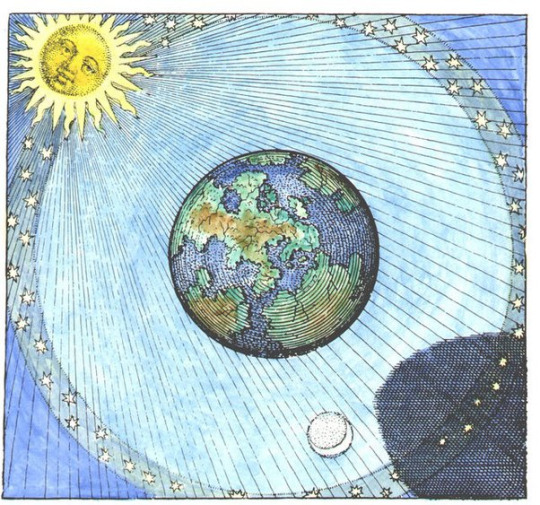
From Atalanta Fugiens
Swan: The albedo, the White Tincture and the White Stone. It swims in the mercurial water, It is feminine and lunar, and able to transmute metals into silver, and represents spiritual purity.
Sweat: The dew or condensation on the side of the vessel during the distillation phase, and is used to wash the dead body of the King during ablution. It’s also the King’s own sweat as he dies, therefore Mercurius as the waters of both life and death.
Sword: Represents “philosophical fire,” the destructive force of Mars and the Red Lion/Dragon. It kills the King (the matter of the Stone), which results in the nigredo stage. (An axe, a knife, Saturn’s scythe, or animal teeth and claws all have the same symbolism)
Tartarus: The dregs or sediment of wine. The Underworld, that which is left behind by the once-living world.
Tears: Mercurial water in the form of the water of life that washes the dead matter of the Stone and cleanses it of impurities. Same symbolism as sweat and dew/rain, the condensation on the sides of the alembic during distillation. In this context, the tears come from grief over the dead King, bird, or lovers.
Temple: Another name for the Vessel, containing all the secrets of alchemy and generation.
Theatre: Alchemical treatises call themselves “theatres,” because they provide a view of the Opus. The Opus itself is compared to a theatrical performance taking place on a stage, and watched by an audience, with all the apparatus being the set and the individual stages being acts and scenes. The theatre is therefore another symbol of the Vessel or alembic.
Tincture: A liquid that is able to tint or color other things. The Stone in liquid form is called a “tincture” because it is able to “color” metals when poured on them to turn them into gold and silver.
Toad: The matter of the Stone during the putrefaction stage, which is black, ugly, and swollen. Also a symbol of prima materia – hardened, earthy primordial matter that’s poisonous but that can be made into the Stone. Means the same thing as the snake or dragon, the crow or raven, and the Green Lion. If paired with a volatile eagle, it represents sublimation.
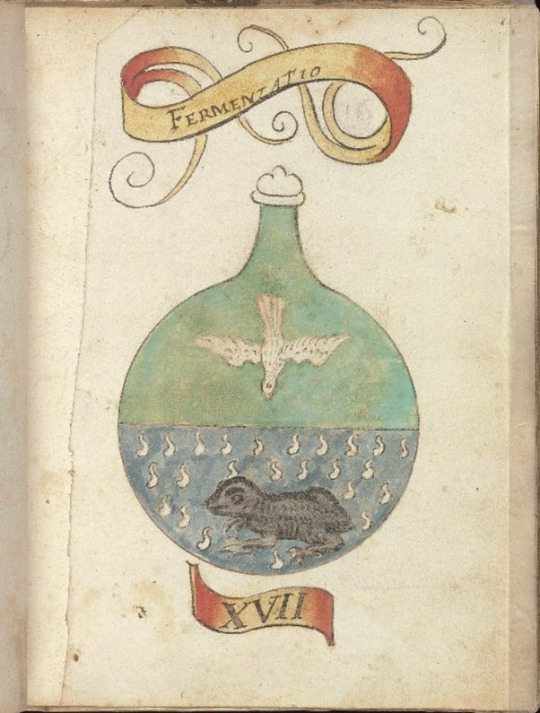
From The Crowning of Nature
Torture: Calcination, reducing a metal to ashes and prima materia during the nigredo stage. This requires being burned in purifying fire. Beheading the king, chopping down a tree, or the bird eating its wings all represent the same thing. This is a symbol of the psychological torment that one must go through during the nigredo, to become self-aware and spiritually pure.
Trees: Prima materia — the force of manifestation, wisdom, the Divine, alternately a creative and destructive force. Yggdrasil provides wisdom to Odin at the cost of his suffering. The Tree of Paradise provides divine knowledge at the cost of sin, etc. Also, “As above, so below,” since the tree’s roots spread beneath it and the branches spread above it. It can also represent the dual nature of mankind, being both divine and mortal, connected to the Astral world and the terrestrial world.
Twins: Sometimes the Red King (sulfur) and White Queen (quicksilver) are interpreted as twins, the two principal forces of nature that are born from prima materia and united with each other. They seem to be opposites, but they’re of the same stock. Sometimes they’re conjoined into a two-headed hermaphrodite.
Unicorn: The masculine aspect of Mercurius, which can penetrate with its horn. Represents the spirit, while the deer represents the soul. The deer and unicorn must both be captured and tamed by the alchemist, so that they will mate with each other, representing the second Chemical Wedding between soul and spirit (during the albedo stage). The unicorn can only be tamed by the Virgin, who represents the feminine aspect of Mercurius.
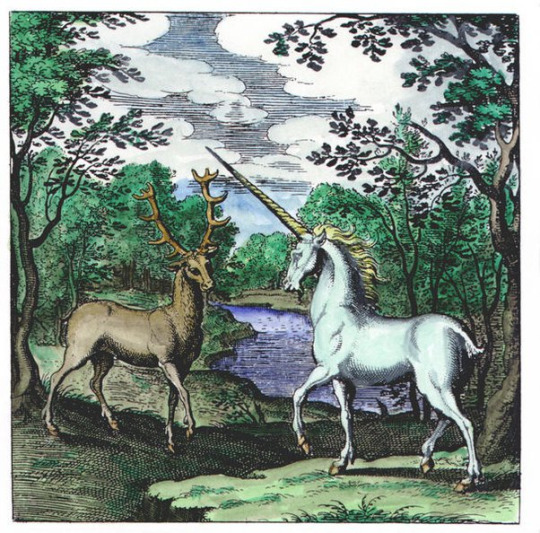
From The Lambspring
Urine: Mercurial water during the putrefaction stage, the universal solvent.
Venom: Alkahest — mercurial water at the beginning of the Opus, as a universal solvent that burns and destroys everything it comes into contact with. It “kills” the matter of the Stone during the nigredo stage, reducing it to prima materia. It is symbolized by venomous animals (or animals thought to be venomous) like snakes and toads. Also symbolized by the blood of the dragon or Green Lion. The venom is then transmuted into the water of life. Spiritually, this is a symbol of the psychological turmoil that you go through when you first become aware of your Shadow or lower self, which becomes a blessing once you overcome it. Self-awareness is painful at first, but is a means towards divine knowledge and purity. (also called vinegar)
Venus: Represents the metal copper, and the color green. She is the impure version of the Divine Feminine, just as Mars is the impure version of the Divine Masculine. She first appears as a “whore,” representing the impure matter of the Stone that quicksilver (a purer version of the Divine Feminine) must be extracted from. Mars and Venus are the alchemical couple before they become Sol and Luna. Sometimes she also presides over the Chemical Wedding and its results, wearing green. The matter of the Stone turns green just after the black nigredo and just before the rainbow Peacock’s Tail.
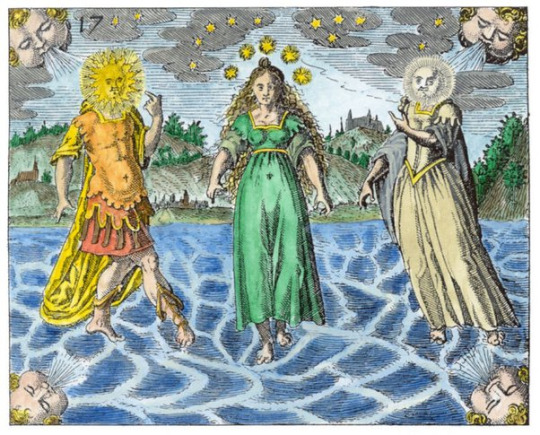
From Philosophia Reformata by Johann Daniel Mylius
Vessel: The flask or alembic in which the Philosopher’s Stone is made. Spiritually, it represents you – your body and consciousness. Your microcosm, in which the Great Work takes place.
Viper: The impure matter of the Stone at the beginning of the Opus, and also the mercurial spirit that is released from it when it is dissolved. It is poisonous and violent, because it has not been refined yet.
Virgin: The feminine aspect of Mercurius. Prima materia, which was “impregnated” by God to create the world, and generates all things. Also a symbol of argent vive (quicksilver), the cold and moist feminine principle. Represented by Diana (Artemis), the virgin huntress, who is also a symbol of the Moon (i.e. the Queen). Sapientia (wisdom) is also a form of the Virgin, this time representing the Philosopher’s Stone. In this aspect, she is a cosmic world-soul (similar to Hecate in the Chaldean Oracles). “Virgin’s milk” is the purifying and transforming form of mercurial water, and the White Tincture.
Vitriol: Sulfate, or sulfuric acid. “Green vitriol” (iron sulfate) is the impure matter of the Stone (i.e. the Green Lion), while “red vitriol” is purified sulfur.
Vulcan: Hephaestus, the smith of the gods, who is the archetypal alchemist in Paracelsian alchemy. This is probably because he works with metal and makes things out of gold. He also represents the “secret fire,” the purifying divine fire.
Vulture: The Bird of Hermes and a symbol for the entire alchemical process, because it is black, white, and red.
Water: The element, the essence of peace. Prima materia, primordial creation, chaos, darkness/the Abyss, philosophical mercury. It is cold and moist, and contains infinite possibility and creative potential, as well as volatile destruction. Also represents the Divine Feminine (i.e. the womb of creation). Symbolized by the Moon and quicksilver (mercury). In its destructive form, mercurial water is the universal solvent that reduces everything to prima materia, and then it transmutes into the purifying and revitalizing water of life.
Watering [plants]: Watering the philosophical tree symbolizes distillation and ablution, imbuing the body of the Stone with its spiritual essence.
Well: The vessel during dissolution, the container for the mercurial water. Another symbol for the baptismal bath or fountain.
White: The albedo, the second stage of alchemy, when the vapor from the dying matter of the Stone rises to the top of the alembic, and the dead body of the Stone is washed in the mercurial waters. The human soul is washed clean of its sins and sorrows at this stage, and is capable of receiving divine love and inspiration. It represents purity and the giving of new life. Symbolized by milk, white roses, lilies, silver, snow, the water of life, the Moon, the swan, the dove, and the Queen.
White Elixir: The White Stone in liquid form, an elixir with the power to transmute base metal into silver, obtained at the albedo stage. It can cleanse anything of its stains and purify matter into a near-perfect state. It is the milk that is “fed” to the baby Philosopher’s Stone during cibation. (Also called the White Tincture).
White Foliated Earth: The matter of the Stone in the albedo stage, which has decomposed, been purified, and become white fertile soil. The seed of gold is “planted” in it, so that the Stone will be able to transmute base metal into gold. The white earth is watered when the soul reunites with the body. Symbolized by ash, dust, salt, or snow, and Luna/the Queen.
White Stone: The matter of the Stone as it is during the albedo stage, able to transmute base metal into silver. It is the mundane body having become pure and spiritual through repeated refinement (distillation/sublimation). Symbolized by Luna, the White Queen.
Wind: The vapor at the top of the flask, Mercurius during the sublimation stage. It is the soul that contains the life-spark, “the wind shall carry it in its belly.” The Stone at its most subtle. Eventually, it condenses and turns to water, then falls back to Earth again. (Also called zephyr)
Wolf: Antimony. It devours the body of the King when he dies during the nigredo stage, symbolizing his destruction by the mercurial waters. Similar symbol to the Green Lion.
Womb: The vessel, in which the Stone is conceived. Also a symbol for the bath or fountain that cleanses the matter of the Stone, and a symbol for the white foliated earth in which the “seed” of metals grows. The earth is “impregnated” by the spiritualized soul, which condenses and falls to the earth. When this happens, the Stone is born.
Worm: Another symbol for the mercurial water and secret fire, that destroys and then revitalizes matter. Interchangeable with the serpent or dragon. It decomposes the dead body of the Stone during the putrefaction, eating away all corruption.
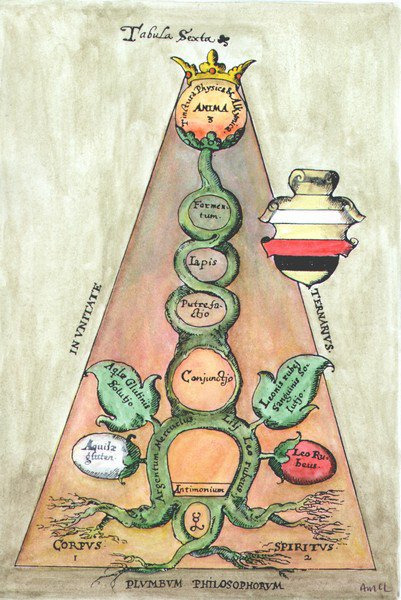
From The Marrow of Alchemy by George Ripley
#alchemy#alchemical symbols#alchemical symbolism#hermeticism#hermetic symbolism#alchemical#mercurius#occult#occultism#occult symbolism#dictionary#symbolism#symbol dictionary#philosopher's stone#long post
158 notes
·
View notes
Note
Fair enough. My source was multiple sources btw. That was a compilation of consistent pieces of information regarding the symbolism of Crescent Moons that I had gathered. Regardless I appreciate the perspective you offered. I will never fault you for simply giving me your analysis on things. Once again thank you for the time & effort you put into your posts and I hope you have a great rest of the day. -EmperorLuffy
Hi EmperorLuffy, hope you have had a good day so far. (:
Yeah I am still dubious because when you get really specific like that, it can be less certain. Like I was wondering if the Norse feminine solar and masculine lunar applied to Ren and Nora because of Nora's obvious Norse background but I don't know if they went that deep lol. I realise that I sound like a hypocrite because I think, for instance, Rhodopis is being referenced, but in deference to Rhodopis, you can just see that on the plain Wikipedia page for Cinderella, and there's a lot of surrounding context in the story to suggest it's relevant.
I also went and consulted A Dictionary of Alchemical Imagery by Lyndy Abraham, which is the source I'd expect to be referenced if they were using alchemy (given how easy it is to find lol), and they are using a bit of it with the red/white/black/yellow scheme, but I can't find anything on crescent moons specifically. There's only one spot crescent comes up which is on page 98-9:
Of all the planets and metals, only the symbol for mercury is androgynous, containing the symbols for both sun (male) and moon (female), the circle and crescent. Flamel wrote of mercury that it contains ‘a twofold metallic substance, namely, the inner substance of the Moon and that of the Sun’ (HM, 1:143).
(Emphasis mine)
So in this case it's that the crescent is just shorthand for lunar imagery generally, which is about what I'd expect. If you look at alchemical art that's how the moon is depicted.
And ofc requisite citation which is that another user, hamliet, writes much more on alchemical storytelling in R/WBY than me, my focus is Jung - so I hope I'm not treading on toes referencing this lol, but Abraham is the one source I'd definitely be looking at for getting more specific with the imagery.
That Cinder would have lunar imagery alone is already interesting enough imo. I guess the question I have is why do you think crescent moon is symbolism alone to be necessary? And again imo this stuff needs to be obvious, what we've got is lunar imagery alone for her.
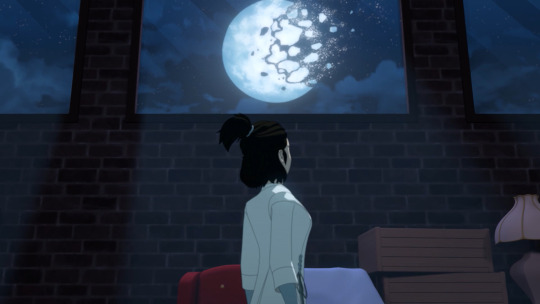

and you want to work forwards not backwards, not looking for complicated imagery but it being communicated, that's why it's visually potent. To go even further that's why you have scholars such as Campbell who would say this stuff is attuned deep to your subconscious that it doesn't need to be complicated in observation, you already know what's being conveyed.
Tbf I think there is a grain of truth in that, that's the purpose of artistic imagery, but I think how far he goes wouldn't be palatable to most people now.
Thanks for your ask again. <3 I'm glad I can offer something interesting.
#seraphina's asks#user: emperorluffy#cinder fall sadsack tag#as soon as I mention the alchemy I just have to add the requisite disclaimer I'm a dummy#and I'm a very small blog and a total loser so please don't judge me lol
0 notes
Text










Philip Ball, Seeing Red; Archive for Research in Archetypal Symbolism, The Book of Symbols: Reflections on Archetypal Images; David M. Odorisio, Of Gods and Stones: Alchemy, Jung, and the Dark Night of St. John of the Cross; C.G. Jung, Collected Works of C.G. Jung, Volume 14: Mysterium Coniunctionis; Jo Hedesan, The Four Stages of Alchemical Work; Lyndy Abraham, A Dictionary of Alchemical Imagery.
#archetype#archetypal symbolism#color symbolism#alchemy#psychoanalysis#depth psychology#theurgic psychology#carl jung#c.g. jung#philip ball#david odorisio#jo hedesan#lyndy abraham#david m. odorisio#there's still so much more i could post but this is already a bit overwhelming.#αἰνελένη#miscellanea
229 notes
·
View notes
Note
Alright here goes The central tenet of alchemy is solve et coagula dissolve and then coagulate. The process repeats, rinses, and repeats again and again throughout the steps “each time at a more refined level.” The point of a chemical wedding is to reconcile opposites Lyndy Abraham the author of A Dictionary of Alchemical Imagery describes the chemical wedding as a crucial operation in the creation of the philosopher’s stone.1/2
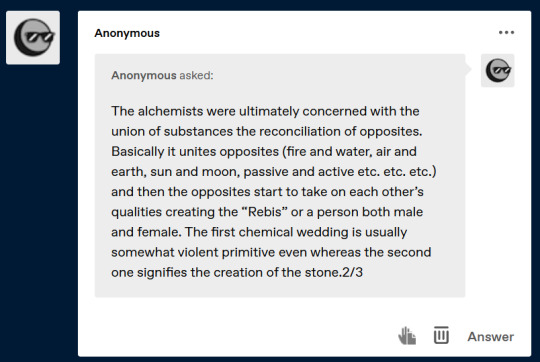
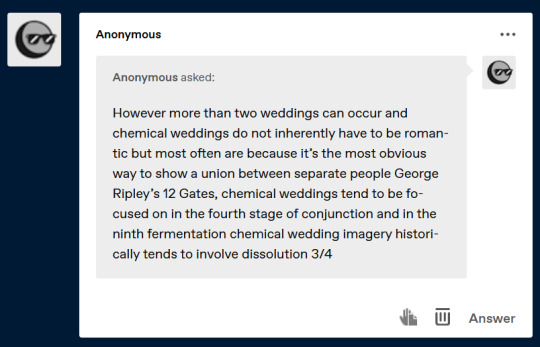

@_@ oh dear, my head is spinning
Basically what I'm getting from this is that a Servamp not seeming to match their Sin in an obvious way or having previously not aligned with their Sin is an intentional thing? That or the Contract pairing Sin and Virtue together might be another step in this process?
idkkk, this might as well be greek to me WHEEZE
Thank you for sharing, though! It's really interesting and I'll have to do some further reading later
3 notes
·
View notes
Text
The episode opens up showing Jenny (Lyndie Greenwood) in a dystopian future, teaching children. An alarm is given about a sighting. Jenny asks how many, and is told it’s ALL of them. They herd the children to safety, arm themselves and step outside and see all four Horsemen of the Apocalypse ride in to the compound. The Horsemen are devastating and while Jenny is doing damage to one in particular, she is knocked out by War.
Jenny awakens to War restraining her and Lara/Molly (Seychelle Gabriel) slugging her. Jenny tries to get Molly to understand that Dreyfuss has done nothing but lie to her, but Molly is intent on bringing her back for a public execution, and preventing anyone else from suffering what she thinks she suffered. Lara insists that Jenny not call her Molly. They struggle, Jenny pulls out a knife, twirls around and strikes War in the mask with the specially treated knife. This cuts off a part of the mask. Jenny is impaled, and as Molly looks from dying Jenny to War, she sees that her mother IS War.
Back in Dreyfuss’ lair, Molly shows Dreyfuss (Jeremy Davies) the knife Jenny used. She starts to tell Malcolm that Jenny told her that War was…but, Malcolm interrupts her telling her not to believe that her mother was War. But Jenny hadn’t said it was her mother. Malcolm says he’s heard that rumor before. They hug it out. (ugh!)
Although Molly thought Crane was dead, she wanders into what is supposed to be an empty prison cell and sees Crane (Thomas Mison)! Crane confirms that Molly’s mother was transformed. Crane had secreted away information about The Traveler’s Spell, and hands it to Molly, telling her she must use it to save her mother. Molly pokes around in Malcolm’s room to find further information on the spell.
Malcolm shows up and Molly challenges him. He says he didn’t take her mother away, it was fate! Molly has activated the spell and as Malcolm shoots at Molly, she jumps through right as past Malcolm is shooting at Diana (Janina Gavankar) in the forest. He misses and we see Crane transformed into War. Molly views this (initially) as success, as her goal was to avoid her mother being turned into War.
Dreyfuss is astonished at this turn of events, and a little disappointed because he had plans for Crane. Diana demands that he be returned, but Dreyfuss says it is a one way ticket. Dreyfuss tells Lara/Molly that clearly he has a use for her, wait, had, wait – those tenses are complicated with time travel. He asks Crane to kill them, but Lara/Molly slices War with a knife which, surprisingly, damages him.
Lara and Diana drive away trying to figure out what to do. Lara is confused because since she was successful in intervening, her timeline and Molly’s timeline are separated and now the future has been changed. Diana wants to get Molly, but Lara says she’s safer away from them. Diana calls young Molly (Oona Yaffe) to check on her, and she’s fine. Lara explains that Dreyfuss actually found her later after her Mom disappeared, Dad was MIA and Molly ended up in the system.
Molly and Diana meet with Jake (Jerry MacKinnon), Alex (Rachel Melvin) and Jenny at the Vault. They discuss that Lara is truly Molly from the future. They haven’t located any literature on recovering someone from being a horseman, but Diana shows that they have Crane’s blood on the knife. On the shelf, the black goo that they should have destroyed is bubbling away…They note that there is a compound outside Camp David, which means there is a Horseman very close to the President. The jar breaks, and the goo surrounds the invincible knife.
War, and Jobe (Kamar de los Reyes) have Headless’ ax, and discuss the rune they need to recharge it. It’s hidden but Jobe says nothing stays hidden from him for long. War shows up, clearly damaged. Jobe has him hop into a coffin with lit runes to regenerate. He explains Crane didn’t have a chance to bond completely, but after awhile regenerating, he’ll be bonded and at full power.
In the vault, the team discusses how to save Crane when Bannaker’s security system is triggered. It turns out that Henry (John Noble) has emerged from the black goo jar. A bit of Henry’s soul mixed with the blood on the knife to resurrect him. Henry explains he was formed out of Crane’s thoughts, so he’s the son Crane wanted him to be. Great lines. Diana: “This is Crane’s son? Kinda old.” Jenny: “Tell that to your 30-year-old daughter over there.” Diana: “Point taken.” (The dialog this season has been great. Very witty.) Henry figures out that Crane has become the horseman of war. “Like Father, like son.” Henry said that there was a spell that could release the soul of War. Jenny confirms they were going to release Abraham Brunt, but Katrina died before they could execute the spell. The team is concerned about whether they can trust Henry (with good reason) but they seem to have no alternative.
They return to the vault to find it was torn apart and someone has liberated something very powerful, but they don’t know what it is. They separate. Lara goes with Diana to find the spellbook. Diana figures out that Lara/Molly is angry with her. And, because of timing, Dreyfuss took advantage of Molly’s vulnerability. Diana reassures Lara that this was not her fault and she shouldn’t feel guilty. Lara reminds Diana that the future has been rewritten.
The vault team conducts an inventory and figures out that the item missing is the Draguar Stone, which can resurrect the dead. Jake figures out that Jobe is collecting artifacts to charge the ax. They are looking for relatives or people with a strong connection. Jenny realizes that he’s resurrecting the Hessian soldiers who drowned…by Sleepy Hollow.
In a scene resembling something from Pirates of the Caribbean, Jobe resurrects a bunch of Hessians. The team has a limited amount of zombie destroying bullets, so Jenny says make them count. Molly, with Diana, executes the spell using the connection that Molly has with Crane, and she appears in a room with a multicolored box. She calls to Crane but he screams to get away. Molly reasons that Crane is being broken down. She tries to figure out how to reconstitute Crane. Crane shouts a warning that “he’s here.”
Jenny, Alex and Jake are engaging with the Hessians. They think they got them all, when another larger wave crests the hill. The Horseman breaks into the prison chamber and strikes Molly with the ax. Lara (with Diana) spits blood out and falls forward. War continues to come at Molly, but she reminds Crane that she and he are the Witnesses, which jolts him in time to block the blow to Molly. Crane cradles the injured Molly. Molly asks Crane why they are still in the prison, and he says before he fully separates from War he wants to take advantage of his powers. Molly wakes up with Diana and says Crane’s free and that he said that Diana should get that cell phone Molly’s been asking for and the earrings…
The team fighting the Hessians is out of ammo, and engage in hand-to-hand combat. The Horseman arrives and slays the remaining Hessians. Stumbling away, War’s armor falls away and Crane emerges. The team comes to his aid. They ask if the Horseman is gone, and Crane says he still hears the siren call, so War isn’t gone.
Jobe is breaking the bad news to Dreyfuss that he’s lost Crane, but that they haven’t lost the essence of War. And, Jobe says, they have the perfect host for War, one who’s already hosted it before. Jobe introduces Henry to Dreyfuss, who is reluctant to trust Henry, but Henry says that the humans have made a mistake in trusting him. Off they go to have some tea.
Grade: A
That black goo was sure to play a future part in the show, and it did, resulting in the resurrection of Henry. He was convincing to the team, because he always was charming in a pretty dangerous way. But, is Henry TRULY evil, or was there some redemption? Given that he came from the black goo….my money is on his evilness. It’s hard to believe there is only one episode left. A 13-episode arc, just like season one started out to be. I hope that we get a fifth season. It’s interesting that we get older and younger Molly both in the same timeline. I continue to be impressed at the impression Tom Mison leaves regarding his closeness to Molly, even with the actress playing older Molly. It’s very sweet.
Next Episode: “Freedom” airs on Friday, March 31, 2017 at 9:01 pm on Fox
Sleepy Hollow (S04E12) “Tomorrow” The episode opens up showing Jenny (Lyndie Greenwood) in a dystopian future, teaching children. An alarm is given about a sighting.
1 note
·
View note
Text
The Expanse Season 5 picked up by Amazon Prime Video
If you ever wondered what was gonna happen to “The Expanse”, we have some news for you. After airing the first three seasons on Syfy, the series got cancelled this year. However, according to the Television Critics Association, Season 4 of the series is all set to debut on Dec 13 2019.
Here comes the juice — #TheExpanse Season 5 is officially confirmed. pic.twitter.com/fQ48is9moE
— The Expanse (@ExpanseOnPrime) July 27, 2019
The Expanse Season 4 will release in December 2019
What is “The Expanse” about?
The TV show is based on one of the New York Times bestseller book series known as the “The Expanse”. It is written by Daniel Abraham and Ty Franck. They write under the pen name James S. A. Corey. It is a sci-fi show you need to see for yourself to know what the show has to offer.
The cast of the show includes Steven Strait, Dominique Tipper, Frankie Adams, Cas Anvar, Wes Chatham and Shohreh Aghdashloo. Mark Fergus and Hawk Ostby are responsible for scripting and developing the series.
We’re coming back for season 5!! https://t.co/t2wMbISvUS
What an amazing ride this show has been for all of us & I just want to say thank you from the bottom of my heart to all the fans that have made this dream a reality! #TheExpanse @ExpanseOnPrime pic.twitter.com/b7zT7IuXVw
— Wes Chatham (@weschatham) July 27, 2019
They are also the executive producer for The Expanse Season 4 along with a team of other producers including Jason Brown, Daniel Abraham, Ty Franck, Dan Nowak, Sharon Hall, Naren Shankar, Broderick Johnson, Andrew Kosove and Laura Lancaster.
Season 4 story and additions
The new season will include some new characters such as Sleep Hollow played by Lyndie Greenwood, The Other Two by Rosa Gilmore, Tyrant by Keon Alexander and Saving Hope by Jess Salgueiro.
Getting ready for an interplanetary voyage? Don't forget these essential survival tips. #TheExpanse pic.twitter.com/w8CGsltV7R
— The Expanse (@ExpanseSYFY) July 6, 2018
In The Expanse season 4, the Rocinante crew finds themselves on a mission given by the United Nations asking them to explore new planets beyond the Ring Gate. This season’s official logline is
“Humanity has been given access to thousands of Earth-like planets, which has created a land rush and furthered tensions between the opposing nations of Earth, Mars and the Belt. While Earthers, Martians and Belters manoeuvre to colonize Ilus, the first of these planets, larger dangers await the explorers.”
youtube
Do you watch The Expanse? Are you excited for Season 4 and Season 5 on Amazon Prime? Let us know in the comments below.
The post The Expanse Season 5 picked up by Amazon Prime Video appeared first on The Geek Herald.
0 notes
Text
Mercurius
Deer: one of the best known epithets for Mercurius, also known as the hart, fawn and stag. The fleeing deer or hart symbolizes Mercurius in his role as the intermediary soul which unites the body and spirit of the Stone
- from Lyndy Abraham A Dictionary of Alchemical Imagery
6 notes
·
View notes
Text
Weiss and Jaune: Chemical Wedding 2.0
Weiss and Jaune have begun another chemical wedding this season, and it parallels the second chemical weddings of Ren and Nora and Blake and Yang (Ruby and Oscar have still thus far only had their first).
Okay, okay, I'll back up. I previously wrote this about chemical weddings in RWBY. A chemical wedding is massively important for alchemy stories. It can be platonic, but is most often romantic. RWBY has, in particular, been using direct inspiration from classic alchemical art to illustrate when they've had one.
This scene in RWBY Volume 9 is no different.
Lyndy Abraham notes that
the chemical wedding... [has] the lovers frequently personified by Sol, and Luna, sun and moon. Edward Kelly wrote In this art you must wed the sun and moon.
Herb has a sun and moon symbol on him. Look at his chest. (Link goes to the more simplistic version, but the combined sun/moon is in the image below, from Manly Palmer Hall manuscript 14).
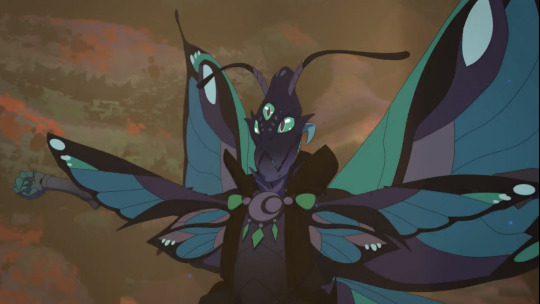
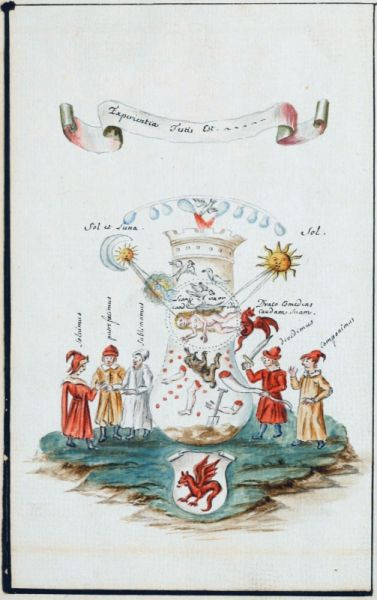
Not only that, but the framing emphasizes that Jaune is Sun and Weiss is moon. Jaune is in the sunlight. Weiss stands in the shadows. In alchemy, shadow is associated with the moon.

Chemical weddings also almost always involve elements of death. In fact, it is death as "Mercurius" that often unites them; in RWBY this is frequently an antagonistic character. Adam for Bumblebly, the Nuckelavee for Renora, and previous Cinder and now the Curious Cat for Weiss and Jaune.
For those who have had two weddings so far, Bumbleby and Renora, we see that their first and second chemical weddings were inverses of the first. Blake and Yang were first targeted by Adam and hurt. Then, they fought Adam and defeated him together. Ren and Nora saved each other but had to leave their village. Then, Ren and Nora defeated the Nuckelavee together.
In Weiss and Jaune's, Cinder taunted Jaune about letting Pyrrha die and about his own sense of self-importance/identity.

Jaune: What is wrong with you...? (seething) How can you be so broken inside... to take so many lives, and then come here and rub it in our faces like it's something to be proud of?!...
Cinder: (chuckling) I'm starting to remember you, you're the dense one that can't tell when he's out of his league....
Cinder: You're just a failure with a death wish.
Cinder also tells Jaune "are you going to let [Weiss] die too?" in reference to Pyrrha. She slides her gaze towards Weiss before throwing the spear at her. Guess what the Cat does?

The Curious Cat also taunts Jaune by appearing as Penny, and then as Pyrrha, mocking him with the two women whose deaths he feels responsible for. Plus, the dialogue between the Cat and Jaune reads very familiar.
Jaune: You... you didn't. You MONSTER... you were the one who killed--who LIED--
Curious Cat: You were never a brave knight either! Just more fairy tale nonsense!
Except, instead of Cinder hurting Weiss to hurt Jaune, this time the Cat gets Weiss to hurt Jaune directly.



These are all references to this classic chemical wedding art:
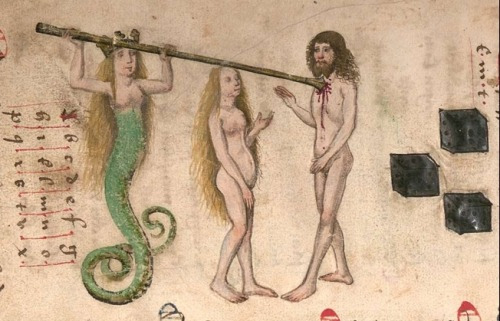
And this one depicting a chemical wedding occurring at a tree from a 17th century Speculum Veritatus (which, for what it's worth, means "Mirror of Truth" in Latin, and Weiss's song is called Mirror, Mirror... that's quite possibly a coincidence but it's so funny I had to mention it).
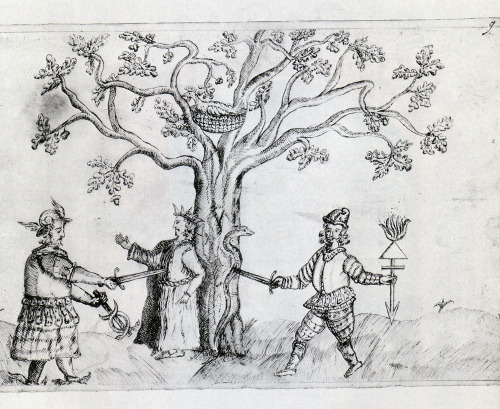
Anyways, chemical weddings typically involve most of the elements. This takes place on a tree (earth), Weiss shoots fire at him, and Jaune lands in a plume of purple air. We've got (most of) our elements.


What happens next? Well, each chemical wedding signifies a change in relationship. Ren and Nora embark on a journey together as kids, then hold hands. Bumbleby run away from each other (separation is a part of the process) and then start a romantic attachment before their final elevated chemical wedding this season (which we still haven't had for Renora yet). Weiss and Jaune become friends and start hanging out after the first one. I would bet this kickstarts a romantic attachment, especially since we've had a couple hints of Weiss developing attraction to Jaune this season.
Besides, Jaune's whole arc has been about being remade and refined from lead into gold. He healed Weiss in the last chemical wedding; I would bet Weiss heals him in a sense this time, but also that Jaune does in fact get remade into something fully gold this time... (and also someone young lol; he's clearly not staying old). Jaune getting a new body during a chemical wedding? Is also, well, alchemically sound.
Lyndy Abraham notes:
The separation of the soul from the body is to free it from its age-old attachment to the body so that it can transcend the turmoil and pull of the merely natural forces of matter. The separation of the soul is a kind of "death" to the world.... the subsequent reunion of this spiritual awareness with the new, purified body means that knowledge gained in a higher state of consciousness can now be put into action, made manifest in the phenomenal world. At this point the male and female energies are united and balanced...
Jaune and Weiss should be able to enter the world of Remnant in a new kind of equilibrium, a la Bumbleby and Renora in the past.
#rwby#rwby meta#weiss schnee#jaune arc#white knight#rwby vol 9#rwby volume 9#rwby vol 9 episode 9#weiss x jaune#bumbleby#renora#alchemy#chemical wedding
70 notes
·
View notes
Text
Rand al'Thor in S2 of Wheel of Time
I wrote about Rand as the Dragon (Reborn) in Season 1 here:
And for some comments about Ep 2.1 see here:
We get a lot of time with Rand in Episodes 2-5, but not a lot of new alchemical imagery until THIS showed up.

This is in the dream sequence with Lanfear in 2.5.
The alchemical process is often depicted as a wheel; in fact, one of the names for the Great Work/Magnum Opus is opus circulatorium. (In her dictionary of alchemical imagery, Lyndy Abraham transates the Latin term as "the circular work of the elements.")
The raw material of the Philosopher's Stone, the prima materia, and in a story, the protagonist is tried and tested and tortured in many different ways. One is being tied to a wheel, as here in the Buch der heiligen Dreifaltigkeit (Book of the Holy Trinity, c. 1410), top right.
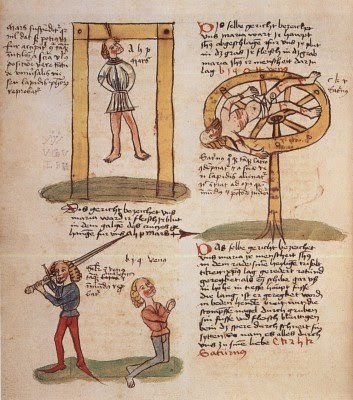
And here (same source):

Since this was only a dream sequence, Rand wasn't actually physically tortured.
In a previous episode, we see Mat stabbing Rand to death--again, not in reality, but in one of Min's visions. You begin to see how useful it is for an author deploying alchemy to include dreams and visions in the story. If you stab or behead or crucify your hero every few chapters, he or she is not going to make it to the end of the book.
For stabbing, I like this image from Speculum Veritatis (1725), which shows both the king (one of the symbols for the Philosopher's Stone) and the Serpent (a symbol for Mercurius, the prima materia) being stabbed. In other words, first the Philosopher's Stone-to-be is stabbed in its initial, primitive, snake form, then it is stabbed in its final, elevated, kingly form. Like many alchemical illustrations, this image shows a sequence of events. In this case, you read the story from right to left.

Finally, it seems that Rand's having red hair IS a marker for him as philosopher's stone-to-be, or in the term TWOT uses, the Dragon Reborn. Logain notices right away that Rand has red hair, which he's tried to shave to disguise himself. You could argue that Rand's action there also fulfills the Hero's Journey stage of "refusing the call."
I must say I am enjoying Season 2 more than Season 1. Maybe because I've figured out who the main characters are finally.
#alchemy#wheel of time#rand al'thor#buch der heiligen dreifaltigkeit#dragon#wheel#philosopher's stone#robert jordan
13 notes
·
View notes
Note
hello hello! rwby fan here, I've been avidly consuming your alchemically focused analysis (/meta commentary) of the show, and as a writer i'd love to know if you have any resources for learning more about alchemy (especially as symbolism)! tysm
Hi! So the go-to is Lyndy Abraham's A Dictionary of Alchemical Imagery. It is sooo useful in collecting all sorts of historical alchemical images and explaining the symbolism in frequently used symbols.
Elsewise, Jung's Psychology and Alchemy is helpful, but it's also Jung, which means it is not an easy read for anyone. So, fair warning. Abraham's is very accessible, in contrast to Jung.
Online, I'd recommend Adam McLean's Alchemy website, which has a great database of different alchemical texts and images. Also, MythCrafts has a lovely series examining the imagery in Splendor Solis, a particular alchemy text that is often referenced (because the art is beautiful).
13 notes
·
View notes
Note
Hi, I saw one of your posts about alchemy and you mentioned about the Dictionary of Alchemical Imagery. Question, is it available online or do you have to buy it? Thanks
Ahh, I bought it! It's by Lyndy Abraham.
2 notes
·
View notes
Text
RWBY as Jungian Archetypes
In which Hamliet and @aspoonofsugar discuss RWBY volume 9 teaser, and also alchemy, and also Jung.
I’ve also talked about Jung’s work in creating literary alchemical criticism. Each of the four stages--Black, White, Yellow, and Red--correspond to a Jungian archetype, and RWBY’s central four embody these respective archetypes in their arcs.
But wait: What exactly is a Jungian archetype?
Well, Carl Jung’s whole theory--which, as I’ve said ad nauseum, is better applied to patterns in storytelling than to real-life psychology--is that there is something called the collective unconscious. You might think of the collective archetypes as somewhat universal images, themes, and moments that we as human beings recognize and respond to in a similar fashion. Archetypes are specific aspects of character, and Jung hypothesized that people confronted different archetypes in their overall journey of individuation. Individuation is the end goal of Jungian stories--to be fully developed as yourself, confident in who you are, aware of your flaws and your strengths.
So, the tl;dr is, insofar as analyzing stories goes:
Collective unconscious: universal tropes that largely resonate with people no matter their culture. Part of the collective unconscious is:
Archetypes: part of a character (usually personified as another character). Archetypes in turn must be faced by each protagonist in order for the protagonist to achieve:
Individuation: the end goal of being fully realized as your own person.
But wait: there’s one more important thing to note. To quote Jung:
all archetypes spontaneously develop favourable and unfavourable, light and dark, good and bad effects.
In other words, there’s a yin/yang to each archetype. I’m not being facetious here; Jung drew on yin and yang (which are linked to Chinese alchemy). In alchemy and in Jung, you can’t have one without the other. The entire premise of alchemy is steeped in the idea of yin/yang, of reconciling opposites, of uniting that which should repel each other.
Blake: The Shadow

The first stage in alchemy is nigredo, or the Blackening. In terms of archetypes, it is associated with the Shadow. The Shadow is all one’s negative traits, the parts of ourselves we’d rather not acknowledge. But the more you run from it, the more your Shadow grows. The only way to grow is to accept your Shadow. Jung writes that confronting the Shadow is:
...the first test of courage on the inner way, a test sufficient to frighten off most people, for the meeting with ourselves belongs to the more unpleasant things that can be avoided so long as we can project everything negative into the environment.... The shadow is a living part of the personality and therefore wants to live with it in some form. It cannot be argued out of existence or rationalized into harmlessness. This problem is exceedingly difficult, because it not only challenges the whole man, but reminds him at the same time of his helplessness and ineffectuality.
If this sounds like Blake’s arc, in particular her struggles after leaving the White Fang and then after leaving RWY, it’s because it is. (Blake’s semblance is even called “Shadow” because Crwby is extra.) She’s struggling to accept her past, to accept her cowardly side, to accept that she can be a loving person. These are all very realistic abuse responses, and this can also be part of the Shadow.
Sugar-chan has spoken at length about Blake’s arc here and here. Blake is also light, though. “Blake” can also mean “white,” showing that Blake can be both. Lyndy Abraham writes that:
the shadow is not something separate from light, but rather integral to it.
Blake needs to reconcile her shadow, integrate with it, to be able to grow.
Weiss: The Anima/Animus
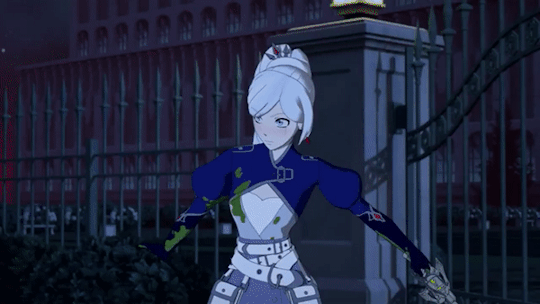
Weiss Schnee represents Albedo, or the Whitening. Jung links this stage to the anima/animus. Which is interesting, because I once wrote a whole meta on Jaune’s arc (heh) in which I pointed to how Pyrrha is his anima, but that the final stage of the anima will likely be embodied by Weiss.
So, what is anima?
Anima (which means ‘soul’ and yes has been literally referenced in the show in that it is the name of a continent) is the internal feminine part of a man’s soul (animus is the male for a female). Don’t take the gender stuff too literally please I’m begging.
But, the gender stuff can be interesting when we consider how both Weiss and Jaune straddle the gender divide: both are both knight and princess in need of rescuing. Sugar wrote a bit more about Weiss’s arc here, Weiss rescues herself. She’s the knight with the sword, and her semblance, Glyphs, include a giant knight. Jaune is of course modeled after Joan of Arc, a female historical figure, and within the show comes to the dance dressed in a princess wedding gown, and has a gift for healing (the wounded healer is another Jungian archetype, and is often female).

We only saw one glimpse of Jaune in the trailer, but he was Not Doing Great. Considering his sword broke after he was forced to kill Penny, this makes sense. Jaune is actually more directly associated with the rainbow “phase” (flash phase between black and white), but his first name is French for yellow, and so it makes sense for him to reach his final development in the Yellow Phase, which we’re in now. Also of note from Jung:
Because the anima wants life, she wants both good and bad.... The anima believes in ... the ‘beautiful and the good,’ a primitive conception that antedates the discovery of the conflict between aesthetics and morals... the good is not always the beautiful and the beautiful not necessarily good... The relation with the anima is again a test of courage, an ordeal by fire for the spiritual and moral forces of man.
If this doesn’t sound like exactly what Jaune’s struggle post-killing Penny will be, then I’ll eat my hat. Also note the fire reference.
In my previous meta on Jaune, I wrote this about the final “stage” of anima integration in development:
Wisdom, of course, being the Sophia stage, which he’ll continue to grow into as he accepts more and more of his anima. There is a chance–and this is just a theory and does not have to be romantic–that Weiss might be the embodiment of Sophia in the story (“Weiss” is German for white, and German for wisdom is “weisheit”; they have the same root word (Old German wis); wisdom is traditionally associated with white in not just alchemy, but pretty much every source of symbolism, and is often portrayed as a beautiful woman). Also, Weiss admired Pyrrha deeply at first, and wanted to be Pyrrha’s partner, and Weiss is the only other person in the void who saw what happened to Penny. So, Weiss becoming more and more like Pyrrha might help Jaune integrate with Pyrrha as his anima, and may provide some much-needed perspective on what happened with Penny.
I don’t mean to suggest that Weiss’s arc is actually as a piece in Jaune’s, because lord above no. But Weiss instead serves as an embodiment of wisdom for her peers--all of them. She is also the only one who saw what happened with Penny, and probably will have to break the news to RBY. She dispenses knowledge and guidance, inspiring Winter, Whitley, even Willow.
What’s the dark side of anima/animus? Well, it’s actually over-identification with the anima/animus (so basically, Pyrrha for Jaune). Jung writes that the anima/animus would then take over “the self, with which the patient's animus identifies. This identification is a regular occurrence when the shadow, the dark side, has not been sufficiently realized.” Weiss has faced this very challenge throughout her arc: does she want to be defined as herself, or as a Schnee (aka her father)?
Yang: The Wise Old Man/Woman

Yang represents Citrinitas, or the Yellowing. This phase is linked to the Wise Old Man/Woman archetpe.
This might seem a stretch at first. How is young, fierce Yang, known for her impetuousness, a wise old man/woman? Well... as Sugar-chan has written, Yang is linked to Knowledge as a theme (she is the one who gets the lamp). In addition, in Jungian terms, confronting/integrating this archetype means reconciling with both positive and negative parental figures. Y’know. Kinda what a major motif in Yang’s arc is.
Not only that, but Jung connects this citrinitas phase to the “mana” personality--the part at which someone begins contemplating existential questions like “why am I here?” and other such theoretical questions (right before proceeding onwards to individuation and a fully realized self). Considering we’re literally in another world at the start of volume 9 and the questions from the trailer were all precisely of this nature, well. I’d say we have some Yang development to finish.
But as mentioned earlier, there is no archetype without its opposite. What on earth could be the opposite to the Wise Old Man and Woman? Jung specifically identified it as a dark mother figure or a witch. Yep. In fact, Jung’s Archetypes even recounts a fairy tale when discussing this archetype in which he writes that:
The hunter or old magician and the witch correspond to the negative parental imagos in the magic world of the unconscious. The hunter first appears in the story as a black raven.
Well, well. Sound familiar? What if I addd that tin the same work, Jung calls the witch the “terrible mother?”

Not only that, but Archetypes contains another elaborate description of the old man/woman archetype and specifically relates it to the concept of... bears (and Yang is based on Goldilocks):
we have a maternally protective goddess related to bears, a kind of Diana or the Gallo-Roman Dea Artio. The sky-woman is the positive, the bear the negative aspect of the “supraordinate personality,” which extends the conscious human being upwards into the celestial and downwards into the animal regions
In other words, my guess is Summer is the positive sky-woman, and the bear is Raven. My guess is there will be a final confrontation with Raven as they’re determining things about Summer.
Sugar-chan also noted to me that it’s possible we’ll see the contrast between Yang as a mother figure herself, and as an inner child (another Jungian archetype):

The wise man a good key to read her arc is actually child/mother. She acts as Ruby's big sis bit is also the baby bear.
Ruby: The Self

With the “Self” archetype representing having actually reached individuation, the Self doesn’t have a personification as another character. Instead, the symbol of the Self is more accurately a mandala, or, the circular symbol that appears constantly in RWBY. And of course, one of the final symbols of the philosopher’s stone is the red rose.
There’s not a ton to say about this just yet, because Ruby’s arc is mostly set-up at this point. But with the drop of the volume 9 teaser, that looks likely to change... because all these questions Ruby is asked? Are about the Self.
Mouse: What are you?
Ruby: Oh, uh, I’m a human. A girl? A Huntress,
Mouse: That’s a lot of things.
Ruby: I’m... Ruby Rose.
Mouse: And to Ruby Rose is your purpose?
Ruby: No, no, that’s my name.
I think this is clearly setting up the core of Ruby’s conflict: who is she? And who does she want to be? To an extent, it’s the question at the core of all RWBY’s arc.
But these questions aren’t just about Ruby. They’re also a likely reference to The Little Prince, a work fans have been associating with Oscar. This is a scene from The Little Prince:
"Good morning," he said courteously.
"Good morning−−Good morning−−Good morning," answered the echo.
"Who are you?" said the little prince.
"Who are you−−Who are you−−Who are you?" answered the echo.
"Be my friends. I am all alone," he said.
"I am all alone−−all alone−−all alone," answered the echo.
Seems a little similar to clip of Ruby trying to find her way through Wonderland, with the bird echoing over and over and her actually making no progress no matter how fast she walks.

Plus, well:
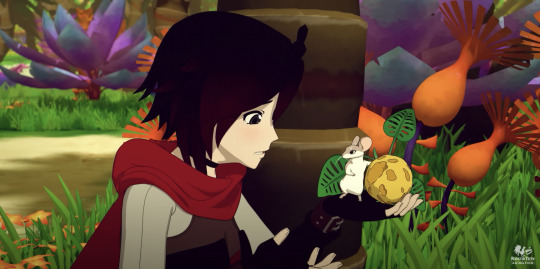
Mouse: What’s wrong?
Ruby: Have you seen other people--humans--like me?
Mouse: Exactly like you?
Ruby: No, not exactly like me. We’re similar, but different.
The Little Prince:
"Good morning," said the roses.
The little prince gazed at them. They all looked like his flower. "Who are you?" he demanded, thunderstruck.
"We are roses," the roses said.
And he was overcome with sadness. His flower had told him that she was the only one of her kind in all the universe. And here were five thousand of them, all alike, in one single garden! ... Then he went on with his reflections: "I thought that I was rich, with a flower that was unique in all the world; and all I had was a common rose."
What exactly this means for Ruby, I’m not sure. Ruby seems to already be aware that she isn’t the only one like her, so that’s unlikely to be her struggle. I am curious as to how Ruby’s identity--and perhaps her overidentification with her mother, another very Jungian concept--will be explored. My guess is, even though Summer is a positive influence, Ruby will avoid the same fate by making a choice different than Summer’s (this would not be to condemn sSummer’s choice, but instead be a sign that Summer is still teaching Ruby even though she’s deceased).
#rwby meta#rwby volume 9#rwby vol 9 teaser#ruby rose#summer rose#rwby theory#alchemy#yang xiao long#raven branwen#weiss schnee#jaune arc#white knight#blake belladonna#Jung#oscar pine
51 notes
·
View notes
Note
Why isn't salt often used to denote characters in literature? Is it like the yellow stage where they just merge it with another or do writers just like the dichotomy?
There are a couple reasons, chief among which is actually because salt is a later addition! Well, late insofar as alchemy is concerned. We're still talking half a millenia.
Originally it was just two: mercury and sulfur. Paracelsus (who lived around the sixteenth century) added salt and named the trio the "three principles." Mercury was the spirit (now usually mind but spirit isn't a 1=1 equivalent to mind), sulfur the soul (ditto but with heart), salt the body. All three of them together were supposedly capable of magically healing and treating all diseases (elixir of life, a common alchemy goal).
The other reason is what I just said above: the body is often "left behind" since alchemy tends, alas, to be very gnostic at times. In other words, the flesh/body/physical is "lesser" than elevated principles like the heart and mind, emotions and logic. So salt too gets left behind. Wonder if it's salty about that :P IM SORRY
Anyways, if you're going by Paracelsus' tria prima theory, Lyndy Abraham describes it like this:
sulphur is the cause of structure, substance, and combustibility, and is the principle of growth. Mercury provides the vaporous and liquid quality, penetrating and enlivening things, while salt keeps matter together by giving it fixity and firmness, and is found in ashes.
11 notes
·
View notes
Text
The Imagination Chamber - “Floral Oil”
@jillcfan pointed out this passage to me a while ago, suggesting it was the first time chronologically in the series that rose oil is mentioned. Though it’s just referred to as “floral oil” in this passage, the characteristics line up with what we come to know as rose oil in TSC.
Sir Charles Latrom every morning applying two drops of a floral oil to the centre of a large silk handkerchief....he’s stolen it from the bazaar in...the Damascus of another world where the flowers were bred for the flesh-like exuberance of their scent. (p. 45)
Although we can’t be sure until the final book comes out, it appears from TSC that rose oil will be the object of Lyra’s quest in Book 3. In other words, in some fashion rose oil will be the physical Philosopher’s Stone of TBOD, just as “dust” was the physical Philosopher’s Stone of HDM.
In a story or a play, the metaphorical Philosopher’s Stone is the protagonist. The hero is put through trials and tortures, dissolved and congealed, pierced, and burnt until he or she emerges purified and able to restore peace and harmony to the world. Romeo and Juliet have to die, but their deaths end the Montague-Capulet feud and bring peace to Verona, for example.
In a work of fantasy, however, there may also be a physical Philosopher’s Stone that the protagonist achieves. The most direct example of this is Harry Potter finding the Philosopher’s Stone in his pocket at the end of the first book, in his facedown with Quirrellmort. The Stone--appropriately red--even appears on the UK cover of the book.
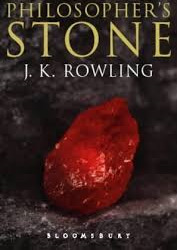
In HDM Lyra and Will’s quest is to save the multiverse by stopping the release and loss of Dust. They do this at the end of TAS when they discover and declare their love for each other. Recall that one name for the Philosopher’s Stone is the Divine Love Essence.
You will not be surprised that “dust” is an entry in Lyndy Abraham’s Dictionary of Alchemical Imagery (pp. 62-63). However, the definition is so strange and multifaceted that I couldn’t relate it directly to the cosmic dust in HDM. In alchemy, dust is synonymous with “ash, snow, white foliated earth, and the Bird of Hermes.” Help!
What is clear is that you must seek out and collect the dust. Abraham goes on to cite the Rosary of the Philosophers (Rosarium Philosophorum, from which I believe Pullman derived the title of Book 3, as I’ve written before).
The Rosary of the Philosophers says of the dust: ‘when it shall ascend most white as Snow, it will be compleat; therefore gather it carefully, lest it fly away into smoke, because that is the very sought for good, the white foliated Earth.’ (p. 62)
Did TAS end Lyra’s (and Will’s) quest for Dust? Will Lyra’s search for the rose oil also involve Dust, or is it a separate quest? Is rose oil the new physical Philosopher’s Stone? The one thing I’m sure of is that Lyra is the metaphorical, symbolic Stone.
On the “white foliated Earth,” Michael Maier provides us a visual in Emblam VI of Atalanta fugiens. The alchemical Great Work was sometimes referred to as “celestial agriculture,” Here the sower is planting the “seeds” in the white foliated earth, which will “grow” into gold.
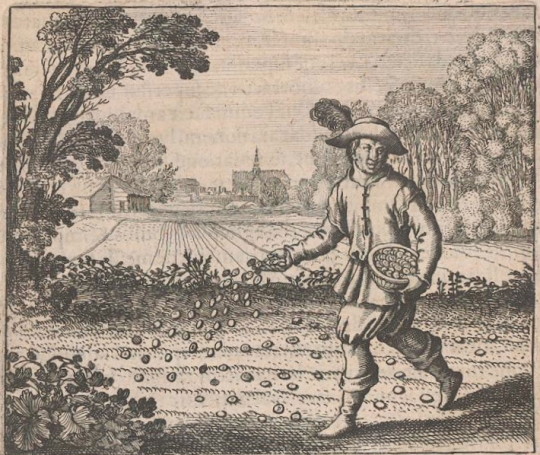
https://alchemywebsite.com/atal_06.html
#the imagination chamber#philip pullman#alchemy#lyra belacqua#dust#atalanta fugiens#philosopher's stone#rosarium philosophorum#the book of dust#his dark materials#lyra x will
8 notes
·
View notes